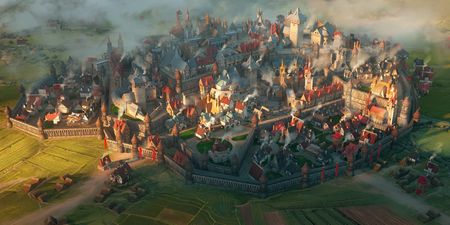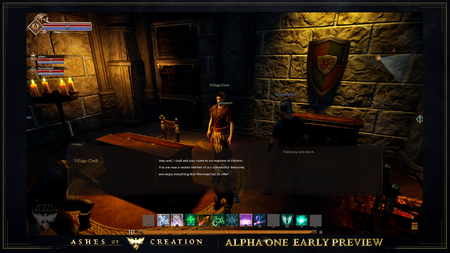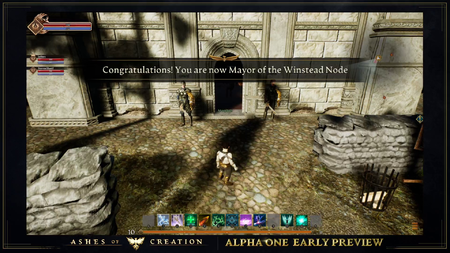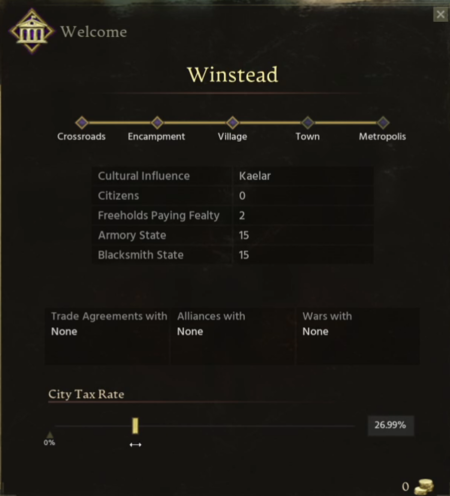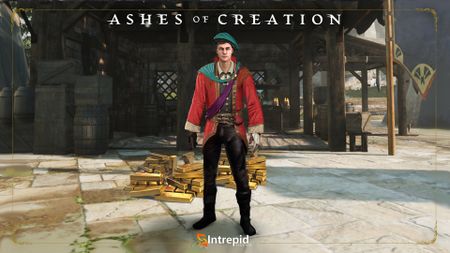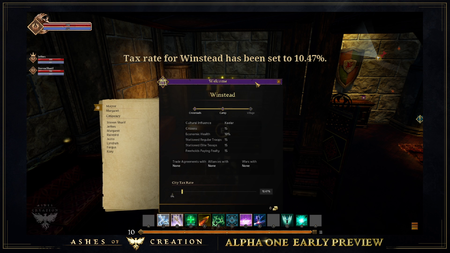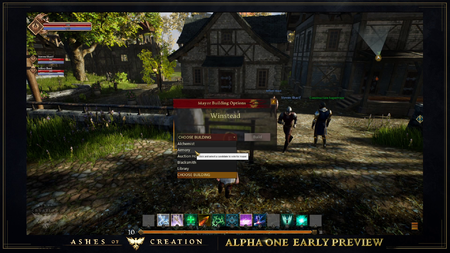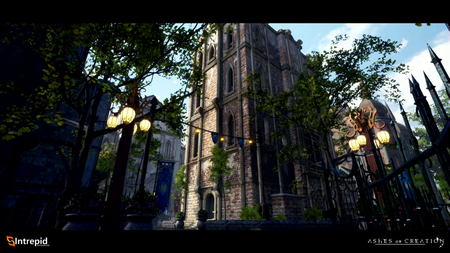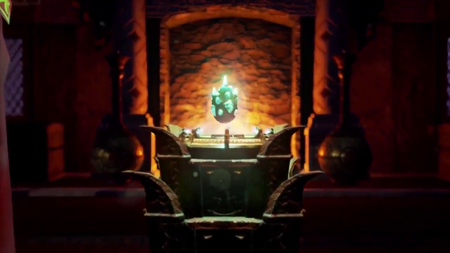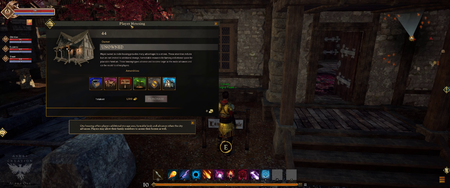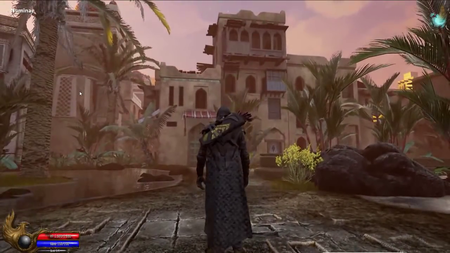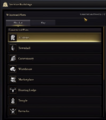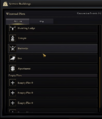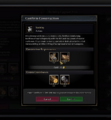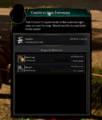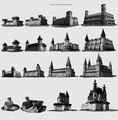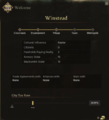Nodos
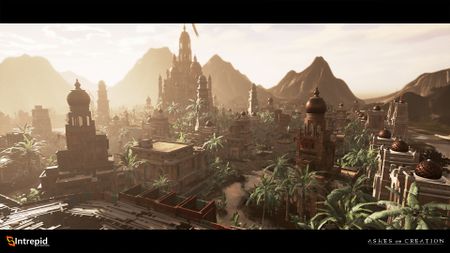
Nodes are a pre-set location, wrapped in a zone of influence, in our world that can form into towns of different sizes. These sizes range from a small camp to a sprawling metropolis. The size of the towns depends on the contribution by players and how far they’ve advanced the Node. Players do not create the footprint of a Node, but within that footprint they do have the ability to own land. Players who are part of the government for a specific Node will have the ability to modify building types and services further, but for the most part, a Node will grow along its own specific path (think about this more as NPCs building these towns out, rather than PCs individually putting buildings and walls up). A Node’s contribution area is larger than the actual town itself, allowing for players to adventure while building upon the town. We call the contribution area the Node’s “Zone of Influence,” and it’s the area where players help to advance the Node they are in.[2]
En cada servidor hay localizaciones de desorrollo o evolución cuidadosamente colocados, llamados Nodos.[3]
- Habrá 85 ubicaciones de nodos comunes en el lanzamiento con 15 nodos de castillo adicionales (5 castillos x 3 nodos de castillo cada uno)[4][5][6] para un total de 100 nodos.[7][8]
- Anteriormente los desarrolladores habían estimado que habría 103 ubicaciones de nodos comunes con 15 nodos de castillo para un total de 118 nodos.[7][8][4][5][6]
- Esta disminución del número de nodos no afecta a la cantidad de alojamientos de jugadores, o a la capacidad del servidor estimada.[9][10]
- We have moved from a 103 nodes to 85 nodes; and there's a few reasons for that. One, when we were doing the calculations behind how- in Alpha 2 and in the game- we want these vassal structures to exist, we had more nodes than what felt meaningful and we wanted to condense some of that those curated story arcs and hooks into the environment and realm around the areas to be more bountiful at a lesser node value: meaning bringing down the node count so that we can increase the richness of each of those nodes more than what was at 103.[11] – Steven Sharif
- Habrá 9 ubicaciones de nodos en el Alpha-1.[12]
Nodes are the heart of the world, they create the ebb and flow of life. At their core, Nodes are pre-set points in the world, wrapped in a Zone of Influence and surrounded by geographic areas that change over time based upon player participation. The world map is divided into regions, with each region containing multiple Nodes. As a Node advances, it influences the types of content within itself and the surrounding areas. Players do not create Nodes, but if they are a part of the government for a specific Node, they have the ability to influence diplomacy, and modify building types/construction and services within that Node. There will be 103 Node locations at launch, each with its own impact on the narrative and development of the world.[7] – Margaret Krohn
Tipos de nodo
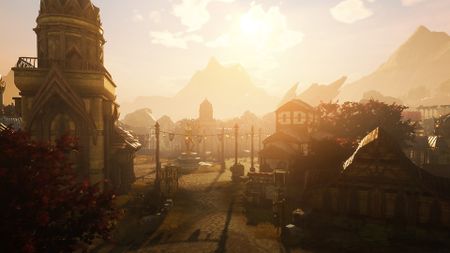
Nodes exist all throughout the world and the location of said node will determine its type; but this type will be... seen at the first stage of development when the first stage when a node propagates real-time assets in the world; is basically these NPCs, these merchants that come into an area and they offer services and/or of stores or whatever the deal may be. You will see the flavor of the node from those merchants. So if it's a military node you'll see military people. If it's... an economic node you'll see merchants. If it's a scientific one you'll see scholars; and if it's a divine one you'll see priests and clerics. So players will have a very firm understanding of which node is which type in order to know how they want to progress.[13] – Steven Sharif
Los nodos se dividen en cuatro (4) tipos de nodo; cada uno de los cuales posee una especialización única.[7]
- Los jugadores serán capaces de identificar el tipo de nodo desde su primera etapa de desarrollo (Expedición) en función de los PNJs que haya.[13]
| Tipo de nodo.[7] | Especialización.[7] | PNJs.[7] |
|---|---|---|
| Nodos religiosos | Fe y habilidades/mejora de equipo | Sacerdotes |
| Nodos económicos | Comercio y mercaderes | Mercaderes |
| Nodos militares | Combate y entrenamiento de clases | Guardias |
| Nodos científicos | Artesanos y construcción | Académicos |
Ashes of Creation allows you, the player, to decide the fate of the world around you. With each Node Type, you can change the flow of resources and goods in the world. Will you grow the largest Economic Metropolis and help guide the riches of Verra, or will you choose another path unlocking new stories filled with allies and enemies?[14]
Los tipos de nodo están predefinidos y serán los mismos para todos los servidores.[7]
- Los tipos de nodo son estáticos. No cambian cuando el nodo evoluciona o esdestruido.[7]
For example, if a level 4 Scientific Node is destroyed, it will become a Level 0 Scientific Node. It will never be any other Node Type other than a Scientific Node. The location of these Types relates to the influences of the area around the Node.[7] – Margaret Krohn
Los tipos de nodo afectan a diferentes servicios y sistemas en cada nivel de avance del nodo.[7]
Los tipos de nodo serán definitivos durante la fase de testeo Beta.[15]
Beta testing will require that the node types be definitive; and that's because of how node types are integrated into the relating and corresponding neighboring points of interest and those quest lines. So it's not something we can swap very easily.[15] – Steven Sharif
Beneficios de los nodos
Cada tipo de nodo tiene un super-poder (habilidad definitiva) que se desbloquea cuando el nodo alcanza nivel 6 (etapa Metropolis).[14]
Beneficios de los nodos religiosos
Los nodos religiosos en estado de Metropolis (fase 6) pueden desbloquear una mazmorra construida de forma procedural ("mega catacumba") bajo la cual estarán conectados todos los nodos vasallos religiosos. Esta mazmorra podría alojar jefes con tablas de "drop" únicas.[17]
Beneficios de los nodos económicos
Los nodos económicos que alcancen el estado de metropolis desbloquearán el super-poder economía conectada . Los nodos económicos con este super-poder comparten su casa de subastas con los demás.[14]
- Hasta dos nodos económicos de nivel metrópolis pueden conectase de esta forma.[18]
- Los nodos económicos de nivel Metropolis permiten establecer precios de venta globales a lo largo de todas las casas de subasta por todo Verra.[14]
- Se podrá pujar por los objetos listados en cualquiera de los nodos conectados y desde cualquiera de ellos.[14]
- Esta "economia conectada" también conecta la metrópolis económica con sus nodos vasallos de tipo económico.[14]
Economic Nodes that have reached the Metropolis Stage unlock the Superpower “Linked Economy”. Any Economic Node with this Superpower unlocked shares Auction House listings with all the others, meaning that the items listed in one Linked Economy Node can be bid on from any other Linked Economy Node. Linked Economies also connect a Metropolis and any Vassal Economic Nodes belonging to that Metropolis.[14]
The Linked Economy Superpower has the potential to create a massive market that spans the world. This will allow players to attain and sell goods with ease, providing those who have access to these Economic Nodes a faster path to fortune in the lands of Ashes of Creation.[14]
Beneficios de los nodos militares
Los nodos militares disponen de los caza recompensas y (potencialmente) reducen la duración de la corrupción en los jugadores.[19][20]
Academic node benefits
Los nodos científicos que han alcanzado la fase de metropolis desbloquean el super-poder de Teletransporte.[21]
- Los ciudadanos de un nodo científico en fase metrópolis pueden teleportarse entre metrópolis y cualquiera de sus nodos vasallos sin importar la fase de este nodo vasallo, siempre que no se encuentre en guerra.
- Los ciudadanos de los nodos vasallos pueden teleportarse hasta la metrópolis y volver.
- Si hay varias metrópolis científicas, un dirigible ofrecerá transporte rápido entre esas metrópolis científicas para todos los ciudadanos de esos nodos y sus nodos vasallos siempre y cuando las metrópolis no esté en guerra.
This will allow Citizens and Vassals of Scientific Metropolises to do things more quickly than others, as fast travel is limited in the world of Ashes of Creation. They’ll be able to exchange goods and information with ease and get to locations in the world at a quicker speed in order to gather crafting materials to create recipes, as well as participate in limited-time events.[21]
Ciudadanía de los nodos
El sistema de alojamiento ofrece la posibilidad de reclamar la ciudadanía de un nodo en fase Aldea (fase 3) o superior.[23][19]
- Los tickets de ciudadano ofrecen ciudadanía en ciertas fases de nodo. Esta mecánica será decidida durante el testeo.[24]
- Un jugador solo puede reclamar la ciudadanía de un nodo al mismo tiempo.[25]
- You can declare citizenship to only one node and when you declare that citizenship. Let's say for example, one guild perhaps wanting to take all their members and have them all declare the same citizenship to a location. The longer a node exists the higher the prize it is to take and some systems with regards to crafting progression and/or rewards and bonuses or the reliquary that we haven't really touched on a lot, those systems are going to be so enticing that from an incentive standpoint it will compel other groups to either potentially break alliances or siege the city in order to take the goods that are potentially in it. So, from an incentive standpoint we have that at play. Additionally, we don't have a cap per-se that we've announced yet on the citizenship aspect of being in a node, but we do have soft caps. It becomes costlier the higher number of citizens each time one new person wants to join to be part of a node. So, there is sort of a soft cap on how many citizens one node can have and it might be that not all in the guild can participate in that area. So, there's a natural divide: A pseudo faction, so to speak between who is a part of that node and who is not.[26] – Steven Sharif
- Your account is bound to one declared citizenship per server, which means that if you have two alts and your main character on one server you may only be a citizen of one node between those three... If you have an alt on a different server, it could be a citizen of a node as well.[29] – Steven Sharif
- La ciudadanía se pierde si el nodo es destruído. Un jugador podrá cambiar su ciudadanía a otro nodo.[27]
- La ciudadanía de los nodos no está vinculada con ser miembro de un gremio. Los gremios no "poseen" nodos.[27]
- Los jugadores pueden pedir en el ayuntamiento del nodo un listado de los ciudadanos de ese nodo. Hacer click en un ciudadano mostrará información acerca de su gremio, sociedad, religión, and viviendas en propiedad.[30]
- No es obligatorio declararse ciudadano de ningún nodo. Estos jugadores no tendrán que pagar ningún impuesto, pero no disfrutarán de los beneficios de la ciudadanía.[31]
Beneficios de los ciudadanos
Ser ciudadano otorga una serie de beneficios .[19]
- Acceso a ciertas funciones y a los servicios de edificios del propio nodo.[32]
- Acceso a los mercaderes que ofrecen tipos específicos de piedras de encantamiento o cambios de estadísticas.[32]
- Acceso a mesas de crafteo del nivel superior.[32]
- Acceso a una entrega semanal de materiales básicos a los que solo se puede acceder desde el relicario del nodo.[32]
- Acceso a "buffs" de eventos específicos.[32]
- Acceso a los títulos.[32][19]
- Acceso a organizaciones y religiones.[32]
- Participación en el gobierno del nodo (votando o presentándose a algún cargo).[19]
- Otros beneficios podrán ser: Reputación, Honor, Lealtad o Méritos.[19]
For example there may be merchant tables that only citizens have access to. Those merchant tables might relate to specific types of enhancement stones or specific type of stat migration abilities. You might have access to mundane crafting benches but the upper-tier crafting benches are for citizens. Citizens only have access to the reliquary and the achievements that the node has from its citizens nearby areas and content like raid bosses that they might kill. They may have a weekly allotment of what specific type of core material they can access from the reliquary and only citizens can do that... You might have access to certain types of buffs that occur during like events; and only citizens can have access to those types of buffs. There are obviously going to be title structures within organizations, within religions and stuff that relate to these events and procedures that only citizens can be part of. That title structure for that specific node.[32] – Steven Sharif
Citizenship entitles you to a lot of benefits for that node including; Titles, reputation, honor, loyalty, merit, and probably most importantly is the nodes government. As a citizen you are granted the privilege of participating in a node’s government. From voting to running for office.[19]
Los personajes no ciudadanos tendrán acceso a los servicios genéricos del nodo, mesas de trabajo vulgares, y recompensas estandar de las quest del nodo.[32]
There are limited functions and services that non-citizens can gain access to as a result. Obviously you want to attract traffic. You want to attract commerce. You want to track taxation. That's possible because those are the means by which the node continues to grow; and in order for that to be attractive you must offer it to non-citizens alike... We don't want to necessarily be super lockout on content per-se, so most quest-lines are still going to be accessible from non-citizens and citizens alike, however the reward tables for those quests might be higher for citizens. You may have additional rewards that be granted based on quest completion and progression.[32] – Steven Sharif
Zona de influencia
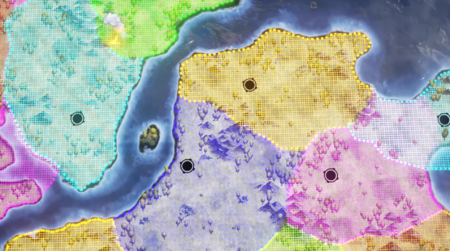
Every Node is given purview over a predefined geographic area called a Zone of Influence (ZoI). No matter where you go in the world, whether you’re questing, gathering, or raiding, you’ll be helping determine which nodes will develop, and what Zones of Influence will expand. Any area that a Node controls is considered its Zone of Influence, including Vassal Nodes, and all Vassal Nodes exist within the Zone of Influence of their Parent Node.[7] – Margaret Krohn
Todos los nodos tienen una zona de alcance geográfico predefinido llamado Zona de Influencia (ZOI). La actividad de un jugador dentro de esta ZOI se tiene en cuenta y se contabiliza para el desarrollo y avance de ese nodo[2]
The main thing that differentiates us from other MMOs is that we have a living, breathing, reactive world... Our world is separated into zones, which are then separated into what we call nodes. Nodes are sort of invisible zones of influence that listen to everything that a player does; so as players gain experience from killing things, gain experience from doing quests, gain experience through crafting things, the node is also gaining that experience. Once a node gains enough experience it levels up and then starts to attract NPCs to it .[33] – Jeffrey Bard
- Realizando actividades habituales como quests, recolección y raids, los jugadores tienen impacto directo para decidir que nodos del mundo se van a desarrollar.[34]
Each Node can form into towns, but are limited by their neighbors. The Nodes have different levels of advancement. There can only be so many of each level. Think of this as advanced settlements needing more elbow room. Nodes encompass more land as they grow and will require more effort to be sustained. This system is a main driver for change in the world because it creates scarcity. As Nodes advance in stages of growth they will lock out neighboring Nodes from progressing, and will absorb their zones of influence.[2]
- Las zonas de influencia conectan todas las partes del mundo sin dejar huecos vacíos.[35]
There is not a space where you will move in to do something and no node will get that experience.[35] – Steven Sharif
- Los nodos del Reino Subterráneo y los nodos ubicados encima de ellos se consideran adyacentes, pero no existen en la misma ZOI.[36][37][38]
- Hasta una quinta parte del mundo formará parte de la ZOI de una metrópolis. Los diferentes nodos vasallos dentro de la "frontera" de una ZOI podrían terminar pareciéndosa a un país o una nación.[39]
Simulación de nodos
This representation does show 111 nodes as part of this particular simulation. I'm not sure what the tick frequency is on this video. It might be something on the magnitude of like every second is probably 12 to 24 hours. So over time you start seeing these larger node systems building up to eventually where you might see Cities and Metropolises after some period of time; and what this allows the design team to do from a tools perspective, as they simulate this idea of how the world is going to progress, is it gives an opportunity to see strange happenings or something that we couldn't necessarily predict but was a possible outcome based on the variables present.[40] – Steven Sharif
Los desarrolladores han creado un simulador de interacciones de nodos para prepararse para la la implementación del sistema de nodos en la Alpha-2.[40]
- Esto simula como evolucionan los nodos y como expanden sus zonas de influencia alrededor de los nodos circundantes.[40]
You can show the initial territories on the Verran map of what these particular nodes have governance over, or their Zones of Influence as we like to call them... As the simulation of this begins to advance and nodes begin to expand their territory and they begin to take over nearby nodes as a result of their of their growth, you start to see these power level ratings that are applied here on specific nodes that determines what type of takeover power it has and and what it pushes back against for other nodes that are looking to take over new territory as they advance.[40] – Steven Sharif
- También simula eventos, como PNJs atacando y deshabilitando ciertos edificios y servicios de los nodos. Si no se contrarestan estos ataques satisfactoriamente, el "marcador de salud" del nodo se verá reducido, lo que provocará una reducción de la ganancia de experiencia del nodo.[40]
It also simulates events: So each of these nodes will have a health ticker: when that health ticker is impacted it'll stop gaining power or gaining or slow down in its gaining of experience; and that's because certain events can affect a node by disabling certain services, disabling buildings. Players don't respond to that horde of zombies that have come out of the nearby ravine then those zombies can attack stables, they can attack service buildings, and prevent particular types of quests or activities and services from happening until it's repaired.[40] – Steven Sharif
- Los asedios a los nodos también se han simulado, con asedios exitosos provocando la destrucción del nodo, y con asedios fallidos, haciendo que el nodo no se destruya pero si que se desabiliten edificios o servicios; parecido a como ocurre con los eventos.[40]
It simulates the sieges if a particular node has a certain frequency that's set where we want to see randomization of how nodes get affected by sieges. Sometimes they'll be destroyed in the simulation. Sometimes they'll have disabled services again, similar to an event, because they didn't succeed necessarily at sieging the node but they did succeed at disabling some of the buildings as part of that siege.[40] – Steven Sharif
- Simula las posibles consecuencias de lo que podría ocurrir por las acciones de los jugadores, como dividir una ZOI a través de una vía fluvial o hacer que los territorios se expandan a islas o entre continentes.[40]
It simulates what players could potentially do as well when the game goes live; and that might include things like splitting up a particular Zone of Influence across a waterway, having your territory expand out to an island, or across continents. These are these are the types of things that we want to see players do eventually obviously but this tool provides the design team the opportunity to see it repetitively and over a fast period of time so they see these different types of outcomes.[40] – Steven Sharif
List of nodes
Fases de los nodos
Nodes advance by collecting experience from the actions of players nearby. As players complete content inside of a Node’s Zone of Influence (the area around the node), they contribute that experience toward the Node’s development. The experience given to the Node may then be modified based on certain Events and Accomplishments. When a Node reaches the experience required, it undergoes the process of advancing to the next stage. There are a few exceptions where a Node cannot advance even though it has the required experience - most commonly, a Node can not advance if a Node is a Vassal of another Node and would advance to the same stage as its Parent Node.[41] – Margaret Krohn
Los nodos disponen de siete (7) fases de avance, con niveles de experiencia para cada una de ellas. Cuando un nodo alcanza la experiencia requerida de la fase en la que se encuentra, avanza a la siguiente fase.[7]
| Fase del nodo.[3] | Símbolo | Nombre alternativo.[42] | Tiempo estimado de avance.[3] | Sistema de alojamiento.[43] | |
|---|---|---|---|---|---|
| 0. | Naturaleza | - | |||
| 1. | Expedición | Encrucijada | Algunas horas | - | |
| 2. | Campamento | Refugio | Bastantes horas | - | |
| 3. | Aldea | - | Algunos días | Casas pequeñas | |
| 4. | Pueblo | - | Bastantes días | Casas medianas | |
| 5. | Ciudad | - | Algunas semanas | Casas grandes | |
| 6. | Metrópolis | Metro | Bastantes semanas | Mansiones |
Avance del nodo
La actividad de los jugadores, ciudadanos y no ciudadanos, como (questear, recolectar, raids, etc.) dentro de la ZOI de un nodo contabiliza para el avance de ese nodo en particular (progresión) a una fase superior.[41][3]
El avance de un nodo desbloquea sus ventajas únicas, aunque puede bloquear el avance de los nodos vecinos hacia sus siguientes fases, al incrementar su anillo de influencia.[44]
- Los nodos avanzan hacia su primera fase muy rápido. Esto habilita algunos PNJs como vendedores o el almacenamiento de objetos.[45]
- Cuanto más avanza el nodo, más ámplia se vuelve su ZOI.[1]
- Los nodos menos evolucionados (conocidos como nodos vasallos) que entran dentro de la ZOI de otros nodos pueden seguir ganando experiencia, pero siempre permanecerán en una fase inferior a la del nodo dominante.[46]
- El sistema de vasallaje comienza cuando un nodo alcanza la fase de Aldea (fase 3), sin embargo, los nodos vecinos a partir de la fase Expedición (fase 1)también bloquean el avance de sus propios nodos vecinos.[47][48]
- El algoritmo de expansión de territorio tiene en cuenta la costa más cercana, los nodos vecinos y el "mapa de calor" de los jugadores en las zonas circundantes durante las últimas semanas y meses.[49]
- Debido la forma en la que el algoritmo calcula la expansión del territorio (ZOI) durante el avance del nodo, hay una pequeña posibilidad de que nodos nodos en la misma fase terminen estando el uno cerca del otro.[50]
- The way that the algorithm expands the territories takes into account a few things: One it takes into account the coast like where's the closest coast. Two it takes into account the neighboring nodes so it can take over and essentially vassal state those nodes, but what's more important is essentially the initial population based on like how players choose their races. Because we have nine different races and four different starting points that branch out, each server's population density is going to dictate essentially the first few nodes that are highly populated and then that initial seed is what's going to determine the node structure as it moves inland into the into the world essentially; and based on the performance and successes of different sieges will determine which nodes that got locked out from the previous the initial advancements what nodes can now be available to advance further. So I really think that with so many variables that are present in the equation of how nodes advance and stay existing with the more variables you have, the higher likelihood there is for there to be a significant diversion in world progression.[49] – Steven Sharif
- Normally the algorithm that's applied to the node territorial expansion will prevent significant nodes from being in close proximity to each other... There could be a perfect storm where all of the algorithmic progression of territory leads to having these nodes very close to each other because there's certain requirements that should that need to be available to satisfy node vassal takeovers; and it's possible that two nodes would never take each other over as vassals and end up close together and spanning their territories in opposite directions: The Tale of Two Cities thing.[50] – Steven Sharif
- Un nodo no recibirá experiencia de los nodos dentro de su ZOI hasta que ese nodo no haya alcanzado su límite.[46]
- Los ciudadanos de un nodo pueden contribuir al avance de otros.[51]
- El porcentaje de experiencia que ganan los nodos será equitativa entre los cuatro tipos de nodo.[52]
- Different people have different resources invested in nodes progressing and it would be a little "gamey" if you could know exactly what was necessary at that point because that would disincentivize people from participating.[53] – Steven Sharif
La mejora del nodo mostrará una serie de animaciones y efectos visuales (dentro del área del nodo).[54][41]
- Los jugadores serán desplazados a zonas seguras si se cruzan con nuevos objetos generados durante el avance del nodo.[54][55]
- Los recursos aparecerán al rededor del nodo y el sistema mostrará una serie de caravanas llegando al nodo con esos recursos. Estas caravanas no podrán ser atacadas.[54]
- Algunos PNJs comenzarán con actividades de construcción.[54]
- Los jugadores fuera del nodo podrán ver como el aspecto del nodo va cambiando a medida que avanza hacia su nuevo nivel.[54]
- The Development Area of a Node is where civilization will appear as the Node advances. As the Node Stage increases, different buildings, NPCs, and services will become available in the Development Area. The higher the Node Stage, the more complex and populated the Development Area becomes. Development Areas will also vary depending on the Node Type - Economic, Military, Scientific, or Divine.[41] – Margaret Krohn
Nodos vasallos
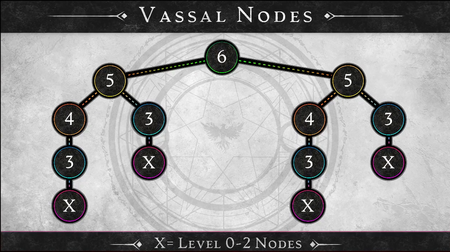
This vassal mode structure tells you what it looks like for a sovereign at a level six metropolis stage; and what it can control at a maximum vassal network is two level five nodes, of which a level five node can control one level four and one level three as direct vassals; and then the four can control a three; and every three can control a one or a two. Now if the three gets removed through siege, the one or the two is removed as well. So that's an important distinction between the three's vassals, which technically isn't really a vassal relationship because there's no citizenships possible. Those vassals don't exist between three and X, but they do exist between four and three, five and four, and six and five. And what this also allows is that because there are 85 nodes that are within the world, we have a buffer zone of about 20 nodes that lives in a max server state. So if you had maximum five metropolises form in a world, you will have a number about 20 nodes that can live alongside those metropolis networks; and when or if a metropolis falls, that extra cushion of nodes around the five metropolis structures allows for the map to be redistricted in a way that is unique. It doesn't mean that one of the fives is just going to pick up where the last six left off and form the same exact metropolis structure. From a territory perspective it has ancillary nodes to play with and expand towards that redistricts the map, so that if a metropolis falls there's a significant difference in the layout of the world and the layout of these almost nation-like territories.[56] – Steven Sharif
Los nodos de nivel aldeas (fase 3) o superior subyugan a los nodos cercanos, convirtiéndolos en nodos vasallos.[7][48]
- Una Metropolis (fase 6) puede tener bajo control hasta dos nodos Ciudad (fase 5). Un Ciudad (fase 5) puede controlar una Pueblo (fase 4) y un nodo Aldea (fase 3). Un Aldea (fase 3) puede controlar un Campamento (fase 2) o unaExpedición (fase 1). Si la Aldea (fase 3) es destruída a causa de un asedio, sus "vasallos" también son destruídos.[56]
- Los nodos vasallos obtienen beneficios de su nodo soberano (nodo padre) incluso si el tipo de nodo padre es diferente al vasallo.[58]
- It is not a bad thing to be vasseled, it is a good thing to be vasseled. It brings many benefits from the Sovereign, which is the ultimate parent of that vassal network down to the vassal node itself; and it allows that vassal node to even live outside of its normal mechanics. You get to adopt some of the benefits that the node type of your sovereign is, even if your node type as a vassal node isn't the same.[58] – Steven Sharif
- Los nodos soberanos recogen impuestos de los nodos vasallos. Estos impuestos no pueden ser cogidos por el alcalde u otros jugadores.[59]
- Los nodos vasallos deben permanecer, al menos, una fase de nodo por debajo de su nodo padre.[7]
- Los nodos vecinos/adyacentes a un nodo de Expedición (fase 1) bloquean el avance de sus vecinos adyacentes. Esto iba a ser probado durante la fase de test de Alpha-1.[47][48]
- Los nodos vasallos aplican primero cualquier experiencia obtenida para compensar su propio déficit (ver debilitamiento de los nodos). Una vez completa, aplican el exceso de experiencia ganada a su nodo padre.[41]
- Si el nodo padre avanza, el nodo vasallo puede avanzar también.[7]
- Los nodos vasallos dan su exceso de experiencia a su nodo padre, y pueden tener sus propios nodos vasallos; siempre y cuando estén dentro de la zona de influencia del nodo padre.[59][7]
- Si un nodo está bloqueado, y ademas de ser un nodo vasallo tiene sus propios nodos vasallos, cualquier experiencia ganada por el propio nodo o sus vasallos se aplica primero a su propio déficit. La experiencia sobrante a partir de ahí se manda al nodo padre.[41]
- When the vassal reaches its cap it overflows experience up to the parent; and so it can be very good early on for parents to get vassal nodes that are very productive- that have a lot of traffic.[59] – Steven Sharif
- Los nodos vasallos están supeditados al gobierno, alianzas, guerras, impuestos, y al comercio de su nodo padre, y pueden recibir ayuda "federal" del mismo.[7]
- Los nodos vasallos no pueden declarar la guerra a su nodo padre o a cualquiera de sus vasallos.[7]
- Los ciudadanos de los nodos vasallos están vinculados a las condiciones diplomáticas de su nodo padre.[7]
If a Node is a Vassal Node and is capped from advancing further, it first applies any experience earned to its own deficit (see Node Atrophy section), and then applies excess experience earned to its Parent Node. If the Parent Node advances and the Vassal is able to grow, it becomes uncapped. If a Node is capped and is both a Vassal and has its own Vassals, any experience earned from itself or its Vassals is first applied to their own deficit. Any experience beyond that is then sent to its Parent Node.[41] – Margaret Krohn
Nodos adyacentes/vecinos
Los nodos adyacentes (nodos vecinos), comenzando por los que estén en fase de Expedición (fase 1), bloquearán el crecimiento de sus vecinos cercanos.[47][48]
- Los nodos vasallos deben permanecer al menos un nivel por debajo de su nodo madre.[7]
- Los nodos Campamento (fase 2) y Expedición (fase 1) no son técnicamente nodos vasallos ya que no permiten la ciudadanía. Si su nodo madre, Aldea (fase 3), es destruido a causa de un asedio, estos nodos también serán destruidos.[56]
Las zonas y su progresión
Las mazmorras, raids, jefes de mundo, enemigos, misiones, eventos, recursos, narrativa y cualquier otro contenido dentro de la ZOI de un nodo tendrán un nivel de dificultad variable; pero escalará con el avance de ese nodo y de su influencia racial.[60][61][7]
We don’t have a strictly level 25 zone. Instead, that zone might have some level 10 creatures near the road, some level 20 creatures deep in the forest, and some level 30 creatures up the mountain. These ratios will change based on the Nodes that inform them, becoming generally more dangerous as the Node grows. All this civilization attracts the attention of Things-That-Should-Not-Be. This does not mean that wilderness areas are safe, by any means. Some may be safe-er, but all will have dangers that even the most experienced traveler needs to watch out for.[62] – Steven Sharif
El gestor del mundo
El gestor del mundo es un algoritmo en Ashes of Creation que controla la dinámica de los elementos del mundo. Actúa como potenciador y sistema de incentivos de varias actividades, para asegurar que ciertos parámetros se mantienen dentro de sus umbrales aceptables.[63]
- A world manager is a technical term to define a server process that lives alongside the game server; and when the game server needs to do things- communicating with other game servers within that grid- it tells that manager and that manager sends it down to the appropriate server.[64] – Steven Sharif
- Los precios de los certificados de caza.[65]
- Un mapa de calor de la experiencia que se gana y se aplica al avance del nodo.[65]
- El algoritmo de expansión de territorio tiene en cuenta las costas cercanas, los nodos vecinos, así como el mapa de calor de los jugadores en las áreas circundantes durante las últimas semanas o meses.[49]
- Debido la forma en la que el algoritmo calcula la expansión del territorio (ZOI) durante el avance del nodo, hay una pequeña posibilidad de que nodos nodos en la misma fase terminen estando el uno cerca del otro..[50]
- El movimiento de recursos y bienes entre regiones para ofrecer misiones de recompensa para los nodos.[65]
- For example if you know iron is being used as a raw resource for a specific crafting path that might drive up the price of mithril or silver; and that will incentivize the market to course correct a little bit. The idea is to provide soft incentives that help to alleviate the demand and also to prop up the supply that might not be present from the economic systems.[65] – Steven Sharif
Debilitamiento de los nodos
Los nodos acumulan cada día un déficit de experiencia basado en el niveld el nodo, llamado atrofia del nodo. The deficit is subtracted from any experience earned that day. Si queda algún déficit, se resta del reserva de experiencia del nodo.[41]
- Puede implementarse un sistema de atrofia, en el que los puntos de atrofia acumulados deshabilitarán progresivamente los servicios de un nodo. El nodo puede ser destruído si se alcanza un umbral de puntos significativo.[50]
- Un diseño anterior consistía en que los nodos podían bajar de nivel en función de la atrofia acumulada.[50][41]
- There are intrinsic problems with reducing a nodes level as opposed to removing the node and it may be possible I'm just gonna say now that we don't actually atrophy nodes to delevel but rather accrue atrophy points that must be replenished over time; and if not it begins to disable services and further compound the atrophy problem; at which point when it reaches a certain atrophy point then the node would just disappear.[50] – Steven Sharif
Gobierno en los nodos
El Gobierno en los nodos es decidido por los ciudadanos del nodo cuando alcanza Aldea (fase 3).[19]
Los puestos dentro del gobierno de un nodo se obtienen a través de títulos que otorgan acceso a los PNJs especiales del nodo.[67]
- Alcaled.[68]
- Sacerdotes, obispos o acólitos en determinados templos.[69][67]
- Líderes de "Patron guild".[67]
- Jefe de los cazarecompensas.[67]
There are a lot of things that you can strive for within [a node] that grant you that special treatment.[67] – Steven Sharif
Alcaldes
Los alcaldes son los gobernantes del nodo y los que controlan el desarrollo de ese nodo.[68]
- Coordinar el tráfico de los recursos que los ciudadanos necesitan mediante el uso de las caravanas.[71]
- Otras tareas del gobernante.[68]
Solo los ciudadanos de los nodos pueden ser elegidos como alcaldes.[28]
- Solo un ciudadanos puede ser elegido por cuenta y por servidor.[28][29]
- Esto podría cambiar a un ciudadano por cuenta.[72]
- Un rey o una reina también puede convertirse en alcalde.[28]
- You may only ever be a citizen of a single node at a time.[28] – Steven Sharif
Los alcaldes obtienen nuevos poderes y responsabilidades conforme el nodo avanza.[7]
- Los nodos tienen una serie de políticas de nodo que son propuestas por el alcalde y votadas por los ciudadanos.[73][74]
- El título de alcalda desbloquea habilidades especiales, así como stats durante los asedios o eventos.[69]
- Los alcaldes son avisados cuando su nodo es citado en un pergamino de declaración de asedio.[75]
- The mayor is made aware of what scroll has been generated if their node is the one that's named on the scroll.[75] – Steven Sharif
Elecciones en los nodos
Una vez que un nodo ha alcanzado la fase de aldea habrá un período de "cooldown" de una semana antes de que comiencen las elecciones del nodo.[77]
- Este período de "cooldown" permitirá a los jugadores establecerse como ciudadanos en la aldea; lo que quizá implique renunciar a la ciudadanía que tuviera en otro nodo .[77]
- Después del "cooldown" inicial, habrá una semana de proceso electoral; a partir de ese momento y en adelante, las elecciones tendrán una preiodicidad mensual.[77]
- Los asedios del nodo no podrán ser declarados en los siguiente 21 días del avance del nodo a cualquier fase.[78]
The village stage is a unique stage because that's when the government system comes online and all other stages past village there will have already been a cadence for the election system and it will follow that cadence, but after the initial village stage is completed there will be a one week period where players have an opportunity to establish citizenship at the village that also provides for the cooldown time that is- that would be present on players leaving another node to participate in in this particular node leveling up. But that after that one week period then there will be a one-week election process and then from that point moving forward will be the one month cadence that the node experiences elections on.[77] – Steven Sharif
Las elecciones en los nodos tienen una periodicidad mensual.[77][80]
- Las noticias relacionadas con las elecciones serán enviadas al email de los ciudadanos.[30]
- Solo los ciudadanos de un nodo podrán participar en sus elecciones.[19]
- Solo los ciudadanos del nodo podrán ser elegidos como alcaldes.[28]
- Un rey o reina también puede ser declarado alcalde.[28]
El gobierno en los nodos y los alcaldes se eligen de formas diferentes en función del tipo de nodo.[1][7]
El gobierno en los nodos divinos es elegido por los ciudadanos mediante la realización de misiones que prueben la devoción y dedicación con el nodo.[81][1]
- La mayoría de estas tareas van a ser individuales y no emplearán ayuda externa.[82]
El gobierno de los nodos económicos podrá ser comprado y vendido por los ciudadanos con más dinero.[81][1]
- Los desarrolladores están a favor de que haya una campaña de financiación pública para los fondos de la campaña y de las contribuciones para los candidatos a la alcaldía.[83]
- Los alcaldes de los nodos militares son elegidos entre los ciudadanos a través de una arena de combate del último hombre en pie (estilo arena de gladiadores).[81][84][85]
- Una idea que está ahora mismo bajo consideración es que los jugadores preparen un campeón con el que luego puedan luchar en la arena, en lugar de usar sus personajes habituales. Este campeón podría ser preparado con equipo y habilidades a través de misiones, además de con materiales y oro con el objetivo de hacer el campeón más poderoso.[86]
- El motivo de esta idea del campeón es que el juego no está equilibrado para el Pvp 1vs1. Emplear estos campeones hará que la arena esté más equilibrada.[86]
- El estilo de combate de la arena será instanciado pero se permitirán espectadores a través de una interfaz.[87]
- El ganador del combate no podrá transferir la alcaldía a otro jugador.[88]
La elección del gobierno de los nodos científicos se realiza mediante un proceso democrático.[81][1] Los registros de a quien voto cada ciudadanos no son públicos.[30]
Poderes de los líderes
Los oficiales dentro del gobierno disponen de importantes poderes de liderazgo.[90]
- Marcar a los ciudadanos extranjeros de otros nodos como enemigos del estado.[91][92]
- Llevar a cabo acuerdos comerciales con otros nodos.[91]
- Los alcaldes pueden establecer impuestos en sus nodos.[93]
- Esto incluye tasas impositivas que aplican a los juegos de taberna.[94][95]
- Asignar el dinero recaudado mediante los impuestos.[74][19]
- Asignar los fondos del tesoro a proyectos de construcción y/o a mejorar las estructuras defensivas del nodo, como muros y puertas más fuertas, trampas, y equipo de asedio.[74][96][97][19]
- Los alcaldes también pueden asignar fondos del tesoro para contratar mercenarios PNJs para defender su nodo durante un asedio.[98][19]
- El dinero de los impuestos solo se puede usar para financiar el desarrollo del nodo.[99]
- Los alcaldes pueden iniciar un sistema de misiones en el que los no ciudadanos puedan participar. El alcalde puede usar una parte de la tesorería o de los bienes del nodo como recompensa por completar la misión. Los jugadores podrán interactuar con el nodo para ver las misiones que hay disponibles para ellos..[100]
- Estas misiones se pueden emplear para traer materiales que ayuden a combatir la atrofia de los nodos.[100]
- Los nodos disponen de una serie de npolíticas de nodo que son propuestas por el alcalde, y que son votadas por los ciudadanos.[73][74]
- There are levers and dials that are present to both the owners of Castles as well as the elected officials of Nodes that during their administration they have the ability to impact and influence the region around them.[103] – Steven Sharif
Los clanes no controlan los nodos.[104][105] Los líderes de clan (reyes y reinas) pueden llegar a ser alcaldes de los nodos.[28]
- Los clanes tienen roles diferentes en cuanto al nodo respecto a los que tienen los ciudadanos particulares.[19]
- Solo un ciert número de clanes puede participar en estos roles.[19]
- La separación de roles de gremio están reservados para gremios peques, medianos y grandes.[19]
- Guild’s also hold separate roles in the direction of the node, than the roles held by private citizens, and only a certain number of guilds may participate in these roles. Separate guild roles are reserved for Small size guilds, medium size guilds and large size guilds.[19]
Impuestos de los nodos
Los alcaldes pueden establecer los impuestos en sus nodos.[93]
- Esto incluye los impuestos para los juegos de taberna.[94][95]
Los alcaldes/gobernantes de los nodos asignan recursos, impuestos, and misiones para ayudar a desarrollar las defensas de los nodos.[70]
- El dinero de los impuestos solo se puede destinar al desarrollo de los nodos. Este oro no puede ser retirado por el alcalde ni por ningún otro jugador.[59][99]
- Las tasas de los impuestos varían según el momento en el que el jugador se unió al nodo como ciudadano. el objetivo de esto, es aplicar cierta presión financiera sobre las poblaciones de los nodos, haciendo que los impuestos sean cada vez más altos conforme el nodo avanza en lugar de establecer límites de población.[106]
Los nodos madre (soberanos) se llevan una parte de los impuestos de la vivienda así como de los servicios que se den en cualquier de sus nodos vasallos.[59][107]
- Estos impuestos no tienen porqué afectar a los ciudadanos, ya que los niveles de impuestos de los ciudadanos vienen impuestos directamente por su nodo,pero las finanzas del nodo si que se ven afectadas por los impuestos recaudados por los nodos madre (soberanos).[107]
Guerra de nodos
El gobernante del nodo puede declarar la guerra a otro nodo e involucrar a los ciudadanos en la causa.[91]
- Esto marca a los ciudadanos de los nodos en guerra, incluyendo a sus aliados, como combatientes.[108]
- Las misiones que implican organización social podrán ser tanto cooperativas como de enfrentamiento en función del estado de guerra de sus nodos madre.[108]
- Un nodo vasallo no puede declarar la guerra a su nodo madre o a cualquiera de sus vasallos.[7]
- Las guerras entre nodos se podrán declarar en cualquier momento, pero los objetivos solamente aparecerán durante el "prime.time del servidor".[109]
- Los jugadores podrán matarse unos a otros en cualquier momento durante la guerra (no solo durante el prime-time del servidor).[109]
- We have conditions that you can set between nodes with regards to either nodes being friendly with each other and acting trade alliances, or they can declare war on nodes similar to how guild wars may function in different games, where those citizens become hostile to each other based on the player government that's elected in the particular node. So those systems all cater to allowing a conflict that's meaningful and that also provides a non-imbalanced relationship between stronger guilds and not as strong guilds.[26] – Steven Sharif
Conflictos internos
No habrá mecánicas relacionadas con guerras civiles en los nodos, pero si que habrá margen para conflictos internos; como puedan ser socavar el liderazgo del actual gobierno o interrumpir las rutas comerciales.[110]
- La única forma de expulsar a un alcalde antes de que termine su mandato es destruyendo el nodo.[111]
We want consequences to matter and if that person got elected then you need to work within the means of the mechanics to get them unelected.[111] – Steven Sharif
Alianzas
Ashes of Creation podrá tener contenido específico que gire entorno a las alianzas.[112]
- Rutas de progresión para alianzas.[112]
- Servicios comunes compartidos de gremios entre miembros de una alianza.[112]
- Alianzas de nodos.[113][112]
- Content that revolves around alliances specifically and progression within the development of that alliance; and the ability to share some common services between guilds that are part of that alliance. I think that additionally allowing alliances to toggle certain relationships with nodes as an interaction is beneficial. That's going to provide an interesting dynamic for players who are either members of the particular node that has the relationship established or members of the Alliance. So I think that obviously building systems is is about creating the channels by which these players can form bonds and the more layers you have around those channels of bonding between the different guilds or players, the more sustainable that relationship.[112] – Steven Sharif
Misiones de nodo
Commissions
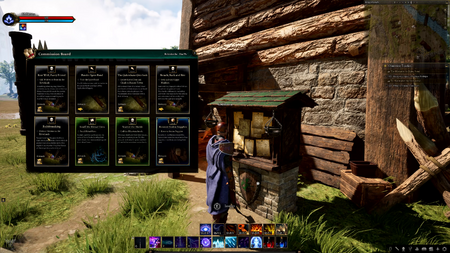
This is a commission board. Every mode has many different commission boards depending on what service buildings are installed there; and commissions are basically these teeny tiny little single objective quests that are like appetizers or quick little digestible things to help you get out into the world and start progressing both your character and your node contribution.[114] – Skott B
Commissions (previously called Tasks) are simple types of system-generated quests with singular objectives that enable characters and nodes to gain XP.[116][114][117][118][119][120][121][122]
- Commissions are posted on commission boards in nodes, which refresh approximately every 30 minutes (subject to change based on Alpha-2 testing). Everybody in the node can see and access the commissions relevant to their level and node reputation.[123][116][124][125][114]
- Everyone sees the same commissions relevant to their level range. Some commissions you see are more rare than others and will require sufficient reputation within the node in order to accept.[123] – Steven Sharif
- Commissions fall into categories based on node type, buildings constructed, social organizations, religions, and node policies.[126]
- Node commissions have dedicated commission slots that are categorized by such things as; node type, buildings constructed, social org, religion and policy.[126] – Steven Sharif
- Commissions are assigned rarities, which scale the rewards for their completion. More developed nodes will offer rarer commissions that are available to players with sufficient node reputation.[123][116][114]
- The rewards basically grow quite a lot depending on the rarity of the commission that gets dealt; and these get dealt for everybody... You can improve your chances of getting rare commissions for your node depending on how you develop your node.[114] – Skott B
- Commissions respond to (and can influence) different conditions in the world, such as weather, time of day, story arcs, and events. Commissions (along with other Node systems) attempt to lead players into areas where relevant content can be found.[124][125]
- Every 30 minutes or so the board will refresh. The server will query a bunch of different information about the world; and this is from ranging from story arcs that are active, story arcs that have been completed, weather, time of day- a whole bunch of different range of factors. The board will attempt to deliver commissions that are relevant to these areas and they will try to lead you into areas where more content can be found.[125] – Tyler Carroll
- Player characters may only have 20 active commissions at one time (subject to change based on Alpha-2 testing). This does not include other quest types, such as side quests, or story arc quests.[127]
- The types of commissions available in a node will be representative of the identity of that node, such as its social organizations, religious organizations, and node policies.[128]
- Q: Will commissions include tasks or quests that are reflective of the node type that they are issued in, or the nodes affiliation with a specific social organizations?
- A: Yes. The answer is yes. Nodes will reflect the theming that the node has and that theming can be influenced by things such as the identity of the node from a node type perspective, what social organizations, what religious organizations, even what policies the node has chosen to enact. Those will all be represented in the types of commissions that the node has to pull from; and so in that way you are solidifying the identity of that node; and again the dynamic state of the world that gets represented.[128] – Steven Sharif
- Commissions are similar to mayoral commissions but they are system-generated rather than initiated by Alcaldes.[119]
- Mayoral commissions are specifically chosen by the mayor, which is similar to the regular commission system, but that system is more system generated.[119] – Chris Justo
Mayoral commissions
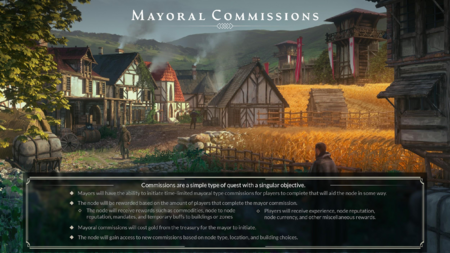
Mayoral commissions serve as a strategic decision base for the mayor. What issues am I facing? What issues do I believe I will face? How is this aligning with my strategy? And then how will my citizens help me help participate in accomplishing these goals so that I'm best set strategically for what I intend to do with those commissions?[132] – Steven Sharif
Mayoral commissions are simple types of quests with singular objectives that are able to be initiated by mayors.[130][131][100]
- Mayoral commissions cost gold from the treasury for the mayor to initiate.[130][131]
- There are a limited number of commission slots available to be set by the mayor at any one time.[119][131]
- Access to commissions is based on node type, location, building choices, and predominant node race.[130][131]
- There will be a cap to the number of commissions that can be accepted by a single player.[119]
- Completing mayoral commissions will reward the node with node commodities, node-to-node reputation, mandates, and temporary buffs to buildings or zones.[130][131]
- Players will receive experience, node reputation, node currency, and other miscellaneous rewards.[130][131][100]
- Mayoral commissions can be conducted by both citizens and non-citizens, but only citizen contribution will generate mandates for the node.[119][131]
- Mayoral commissions are similar to commissions, which are system-generated quests that enable characters and nodes to gain XP.[118][119]
- Q: Is participation always going to be greater for larger nodes by default, or can a small node with close to 100 participation still greatly benefit from them?
- A: That's gonna come down to what commissions the mayor is initiating. Level three nodes aren't going to be initiating mayoral commissions that require thousands of players to participate, because they don't have access to those; where Metropolises that have a huge citizenship base will get access to those kinds of commissions. So the rewards will be proportionate to the node level and the expected amount of citizens.[133] – Chris Justo
Reputación de los nodos
Acciones como participar en la construcción de los nodos, pueden implicar que el personaje gane reputación en el nodo positiva. Acciones como fallar determinadas misiones, pueden desembocar en obtener mala reputación. Esta reputación se gana o se puerde a nivel de nodo.[134]
- Algunos PNJs pueden reaccionar de forma diferente en función de la reputación del personaje.[135][134][136]
- Esto puede implicar precios más altos (para productos o servicios vendidos en el nodo).[134]
- Los guardias PNJs matarán a los jugadores corruptos que vean.[137]
- Los PNJs añadiran a los jugadores a su "lista negra" si ese jugador cura, bufa o asiste de cualquier forma a un jugador que ya tenga en su "lista negra".[138]
- Una reputación negativa puede abrir líneas de misiones en las que el lado más oscuro y sórdido del mundo pueda estar interesado.[134]
- Una excesiva reputación negativa puede provocar que un personaje sea marcado como "enemigo del estado" de un nodo.[134]
- Los alcaldes también pueden declarar a ciudadanos extranjeros de otros nodos como enemigos del estado.[91][92]
- The more good aligned or civilization building aligned tasks that you complete, you get higher positive reputation. But if you get low or bad reputation you could be deemed enemy of the state of a node. You could be deemed a bad actor and it might raise prices for you, but it also might open up certain quest lines that the darker, seedier side of the world are interested in.[134] – Steven Sharif
Edificios de nodo
El gobierno del nodo decide la ubicación y los tipos de edificios de nodo que serán edificador en cada sector del nodo.[141][142][143]
These are buildings that the mayor has agency over determining whether or not they should be a constructed project. Constructible buildings can be selected at open plots that are gained as the node advances. If they elect to begin construction of one of these types of buildings- one of which is the marketplace- it'll grant certain trade benefits as well as some stalls that the citizens may participate in.[144] – Steven Sharif
Los gobernantes deciden como especializar su nodo. Una vez determinadas elecciones han sido tomadas no se podrá cambiar a otras opciones.[141]
- Los edificios del nodo disponen de un "arbol tecnológico" basado en la etapa del nodo. Cada etapa ofrece mejores servicios al nodo, pero se debe cumplis con los requisitos previos para la construcción del edificio.[145]
- Diferentes gobernantes pueden cambiar los edificios dentro de un nodo.[141]
And there could be regime change... If somebody doesn't like the fact that a market was built and they want to re-elect a new government next cycle, they can do so... and that market could be destroyed and a new building take its place.[141]
Cuando el tipo de edificios haya sido escogido, la comunidad tiene que traer rrecursos al nodo (empleando caravanas) ay unirse para construirlos (mediante misiones y similares).[141]
- Los materiales aportados para la construcción de un edificio del nodo se pierden si el alcalde desechar el proyecto.[146]
- El número de edificios, así como la localización de los mismos dentro de un nodo están predefinidos.[142]
Estilo y diseño de los nodos
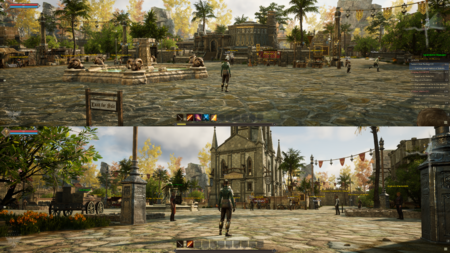
The layout and architecture within a Node’s development area are determined by influential race. For example, a stage 3 Node with the majority of player contribution being Py'rai would have a Py'rai village with Py'rai architecture. Most NPCs would be Py'rai elves, and offer questlines within the Py'rai narrative.[7] – Margaret Krohn
Each player’s contributed experience is flagged with their character race and other identifiers. When a Node advances, the race with the highest experience contribution determines the Node’s style and culture. This style and culture change can happen at every Node Stage. For example, if a Node advances to Level 2 - Encampment Stage and 51% of all experience was earned by Ren’Kai players, the Node will be a Level 2 Ren’Kai Node. If that same Node advances to a Level 3 - Village Stage Node, but the Py'Rai contributed 62% of all the experience earned, then the Node will be a Level 3 Py'Rai Node.[41] – Margaret Krohn
El diseño de un nodo y su estilo es determinado por varios factores:[147]
- La localización y el entorno (bioma) del nodo.[148][149][147]
- Nodes will adjust the local topography to fit the aesthetic and mechanical requirements of the node.[148] – Steven Sharif
- Los nodos ajustarán la topografía local para adaptarse a los requisitos estéticos y mecánicos del nodo.[150]
Currently the way that the platform system is set up, is it's capable of adjusting the topography of the node's footprint, regardless of the surrounding terrain. So the reason for that is we want to have flexibility in the presentation of the node's layout and how it is essentially both from an aesthetic standpoint as well as a mechanical standpoint with node sieges- how it's constructed and that construction should have the ability to take on a variance of different types of topography. So it shouldn't be dependent on the surrounding area. Now that's not to say that the surrounding area isn't going to have some influence over. So for example... we're experimenting a little bit with the platform tech and putting up a node up against the side of a mountain or on the edge of a cliff or something that has a beautiful vista. Those are things that we're going to test out obviously as we continue to work on the node tool and how that platform system works, but the idea is to have the node independent of the surrounding terrain.[150] – Steven Sharif
Some parts are determined by the area it's in. Some parts are determined by the type it is. Some parts are determined by the race it is; and then the rest of it is determined by the mayor.[147] – Jeffrey Bard
- La raza que contribuya con el porcentaje más alto al avance del nodo modificará la apariencia racial de sus edificios, NPCs y objetos.[151][149][41][147][152][153]
- Las razas relacionadas entre ellas no combinan sus influencias culturales. Por ejemplo, los Py'Rai y los Empyrean cuentan como culturas diferentes. Su raza madre, los Pyrian, ya no existen.[154]
- Este cambio de estilo y cultura ocurre en cada etapa del nodo.[41]
- Esto aplica para todos los nodos, incluso los nodos de castillo.[103]
All nodes whether they're associated with a castle or associated with normal node structure has cultural influences that replicate over to the buildings that are produced and the NPCs that are present.[103] – Steven Sharif
- El resto es determinado por el alcalde del nodo.[147]
- Debería ser posible completar varios proyectos de construcción en un nodo durante el mes en el que el alcalde ostenta su cargo.[155]
- Q: How long would you say it will take players on average to fill slash build up a node completely from wilderness to metropolis?
- A: It's one thing to get a node to a certain level: it's another thing to develop the node; and I can't really give you an on-average expectation, because there's a lot of variables at play. There's how many citizens does the node have attracted to it; what's the type of traffic that the node is attracting to it based on things like its tax rates, or the specialization that it chose to spec into, based on the building types it's chosen to build. All of those things are variables that can affect the quote-unquote "average build-out time" of a particular node. So it's difficult to give you an average when there's so many variables along those lines. But the idea is that if there is a particular project that players are interested in in developing based on the node stage, that they would have the ability to complete several of those projects as within a single term of a mayor; and a term of a mayor is one month.[155] – Steven Sharif
Influencia racial
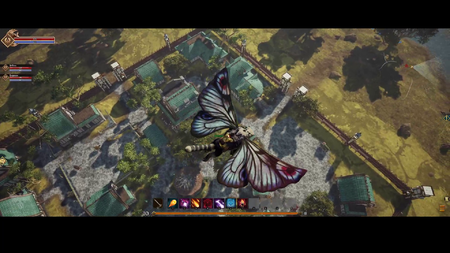
We have essentially sets that exist across all races; and each race that dons those armor sets is going to have their own racial influence on the presentation of those particular sets. So that's something that's unique in how each of the races get diversified. Additionally, the more that one particular race contributes to a node's development, it's going to manifest in that particular node's architectural influences. You're going to see the architectures of those races become manifest within the nodes as well: That's another way that we diversify each race and we present each race's culture in the game as through those architectures, through those props that exist, through the tailoring of the armor sets that the NPC might wear, to the different factions that exist. Factions will have their own affiliation with different races as well. Each race will also have some different nomenclature when it comes to the lore, or comes to locations in the world. They're going to have their own language influences as well: The way they speak is something that's going to be distinct between races; when you have dialogue trees with particular NPCs. So all of those things really go into setting an immersive world where the cultures have their own identity.[157] – Steven Sharif
La influencia cultural se manifiesta diferentes formas, desde la estética de los nodos y el equipo hasta en el lenguaje de los PNJ y el lore.[157][158][41]
- La apariencia del equipo de ciertos sets de armaduras viene influenciada por la raza del jugador.[157]
- El diseño y estilo del nodo está influenciado por la raza que más contribuye ha ese nodo.[157]
- Los beneficios puede que apliquen a los ciudadanos de la cultura dominante, pero también aplica a las mecánicas del nodo, lo que podrá ser beneficioso también a los miembros de otras razas.[158]
- Hay una mecánica de desgaste, que afecta a la experiencia y a la influencia para evitar que una sola raza domine el mundo entero.[159]
- Los PNJs reaccionarán de forma diferente dependiendo de la raza del personaje.[160]
- Los idiomas serán diferentes según la raza del PNJ y en el lore.[157]
There is an attrition and that attrition on experience and influence is heightened based on the performance of the race in the world. So if all these nodes are Orc nodes then their attrition rate is very high to compete with the cultural establishment of new nodes because they have more influence in the world and a popular opinion is against them in their outlying regions that they do not have influence in.[159] – Steven Sharif
NPC racial interaction
- NPCs will react differently to different character races.[160]
- Idiomas will be distinct between NPC races and in the lore.[157]
- Certain quest givers and NPCs may only be present at nodes with certain cultural influences.[161]
- Depending on the cultural influence of the node activates certain types of quest lines and/or sponsors. Some of those are shared, some of those are general. Some of those relate to a progression path that is a first time user experience. Those will be constant across all culture types. Some of them, however, are predicates that spawn when certain story arcs and/or events, or commissions or buy orders become present within the node; and those might change based on the cultural influence of the node. So there is a separation between those populations.[161] – Steven Sharif
Edificios de nodo únicos
Cada tipo de nodo tiene asociado un edificio único que puede ser "activado" en la fase de aldea dentro del avance del nodo. Este edificio único juega un rol principal dentro del progreso de la civilización en el servidor.[14]
Relicario
The reliquary is a node building in Ashes of Creation that is used to house relics.[165][166][167]
- Relics stored in a node's reliquary grant passive and active benefits to node citizens and vassal states.[168]
- Benefits will also be conferred to those who capture, steal or sabotage relics held the reliquary.[168]
- Access to the material components of the relics stored in a node's reliquary is granted to registered attackers after successfully destroying that node in a node siege, even though they are not citizens of that node.[166][167]
- When the node is destroyed, the reliquary's contents become available for spoil amongst the attackers; and now even though they weren't citizens might have access to what they wouldn't have access to before, because they weren't a citizen. They'll have access to grab a number of those instances of that material and that's going to be an important aspect because relics are going to be important as part of the whole crafting scheme. So this incentivizes- it acts as an incentive for players to want to engage and battle with these nodes and try to take what they have.[166] – Steven Sharif
Destrucción de edificios de nodo
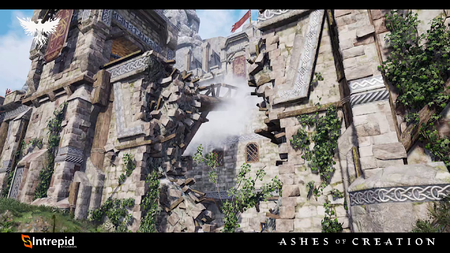
You could be more precision oriented in the decision to attack a city. Let's say it's a rival node that's trying to reach a node stage five or something and you want to disable their ability for the religious system to progress so you target the temple during the attack, or you want to disable their scholars academy from reaching a higher level so that your nodes can; or you want to disable multiple buildings that allow for experience and quests to be undertaken by its citizenship, which prevents them from keeping up in pace of experience gained with your node. These can be more precision oriented and don't have to effectualize an actual takeover of the node.[170] – Steven Sharif
Los edificios de nodo (incluyendolas casas de los jugadores) tienen puntos de golpe y pueden ser dañados o destruidos de diferentes formas.[145][171]
- Eventos que implican PNJs como respuesta a arcos dehistoria o por la atrofia de los nodos.[145]
- Asedios y guerras de nodo.[145]
- Puede que los atacantes no sean capaces de destruir un nodo durante un asedio. En lugar de eso quizá lleven a cabo ataques enfocados a deshabilitar ciertos edificios que ofrecen determinados servicios dentro del nodo. Estos edificios pueden ser targeteados con las armas de asedio y bombas.[170]
- Eventos peligrosos como tornados o huracanes.[172][145]
Si un edificio sufre más de, aproximadamente, un 25% de daño, cualquier PNJ o servicio ofrecido por ese edificio no estará disponible hasta que el edificio haya sido reparado.[171]
- Los jugadores deben reparar los edificios dañados (o reconstruir los destruidos) para reactivar los servicios de esos edificios en particular.[145][171][173]
- Los ciudadanos necesitarán obtener los recursos necesarios para reparar y reconstruir las infraestructuras dañadas.[171][173]
- Los edificios más avanzados requerirán más recursos para ser reparados. Es probable que losalojamientos dentro del nodo requieran una menor cantidad de recursos para su reparación.[174]
Los edificios que sufren daños significativos se destruyen y aparecen como escombros en el terreno que ocupaban.[145]
- El gobierno del nodo debe limpiar cualquier escombro de las parcelas antes de poder reconstruir cualquier edificio. Cualquier requisito previo para la construcción del edificio debe cumplirse de antemano.[145]
- Buildings also live within a prerequisite system. So in order to build down the tech tree of what these buildings provide, as the node grows larger to access stronger building types, you may get a kink in that chain if it's destroyed and you'll have to stand that back up in order to support the service again.[145] – Steven Sharif
- Si el nodo es destruido por un asedio, el campo de escombros que quede contendrá botín que los vencedores del asedio podrán saquear.[175][171][176][177]
- Las viviendas de los jugadores que se destruyan durante un asedio no podrán ser vendidas.[178] El mobiliario y la decoración se conservan y se pueden volver a colocar.[178][179][180]
Player housing
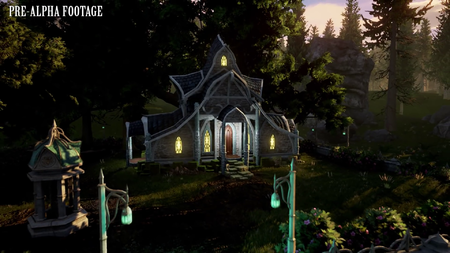
Players will have the ability to survey and develop land anywhere in the world. Be a pioneer deep in the wilderness, build the home of your dreams, and work the land to cultivate resources and supplies. Alternatively, stick with civilization and safety in numbers – purchase a home within the confines of a village and watch your investment grow as that village turns into a city. Homeowners in our game will have the ability to develop their plot of land as they see fit. Focus on farming, animal husbandry, or own your very own smithy. You’ll be able to specialize your land to maximize your profits or your comfort – be sure to choose wisely.[182]
El Player housing es el alojamiento de los jugadores; siendo estos alojamiento persistente, apartamentos y parcelas.[1]
Un jugador puede poseer hasta un alojamiento de cada tipo [184] Uno por servidor en cuanto al alojamiento persistente y los apartamentos; y una parcela por cuenta.
| Player housing | Tipo. | Disponibilidad. | Disponibilidad inicial. | Límite. |
|---|---|---|---|---|
| Apartamentos | Instanciado.[1] | Fase de Aldea o superior.[185] | 50.[186] | Uno por personaje character por server.[187] |
| Parcelas | Mundo abierto.[1] | Fase de Aldea o superior.[1] | Abundante.[186] | Uno por cuenta.[187] |
| Alojamiento persistente | Dentro del nodo.[1] | Fase de Aldea o superior.[1] | 8.[186] | Uno por personaje por servidor.[187] |
Alojamiento persistente
El alojamiento persistente ofrece alojamiento para los jugadores no instanciado dentro de un nodo, también conocido como "in-node housing".[1]
- Los jugadores pueden comprar casas pequeñas de una habitación (cabañas) a partir de la etapa de aldea (fase de nodo 3).[1][186]
- Habrá 8 cabañas disponibles para comprar en la etapa de aldea.[186]
- La cantida de viviendas estáticas o persistentes aumenta como conforme el nodo avanza.[185]
- La arquitectura del alojamiento estático viene definida por la influencia racial del diseño y estilo del nodo.[189]
- Las tabernas y tiendas de jugadores no están vinculadas a viviendas dentro del nodo.[190]
Apartamentos
Los apartamentos son zonas instanciadas dentro de un nodo que ofrecen funcionalidades e alojamiento .[1] Habrá un total de 50 apartamentos disponibles para comprar cuando un nodo avanza a la fase de Aldea (fase 3). Se pueden construir edificios de apartamentos adicionales en la fase de Pueblo (fase 4) si el alcalde decide construirlos y si hay terreno disponible para hacerlo.[186][185]
- El número de apartamentos disponibles aumenta como el nodo avanza.[185]
- Se dijo anteriormente que los apartamentos estarían disponibles en la fase de Pueblo (fase 4) y superior.[1]
The mayor may additionally construct apartment buildings when the node hits stage 4 at one of the building plots in the node, along with cities gaining additional static housing and apartments by default as a normal part of the leveling process.[185] – Steven Sharif
Parcelas
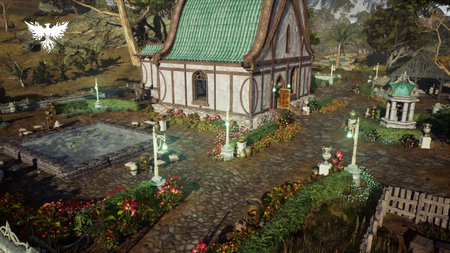
The whole goal of the freehold system is to give everything a purpose and not just have it be like "oh this is my pretty design", but it's a design towards something for your character- towards something for the world.[193] – Jeffrey Bard
Las Parcelas son zonas de alojamiento de jugadores de un tamaño considerable que se pueden ubicar dentro de la zona de influencia (ZOI) de una Aldea (fase 3) o superior.[1]
- Las parcelas están limitadas a una por cuenta.[187]
- Las parcelas tienen un tamaño aproximado de half an acre|medio acre.[195]
- La zona asignada de una parcela no cambia con la progresión del nodo.[196]
- Las expansiones y mejoras estarán disponibles a medida que el nodo avance allows.[195]
- Las parcelas no se pueden vender a otros jugadores.[197]
- Se requieren planos para la construcción de los edificios de las parcelas que sirven para procesar recursos y convertirlos en bienes procesados.[198][199][200][201][202]
- El mejor nivel de procesado solo se puede realizar en parcelas, por lo que obtener una parcela requerirá un gran esfuerzo.[203]
- If a player wants to achieve a freehold they can achieve the freehold, however the amount of effort resources and time that's required in order to achieve that freehold is a large amount. It is something that is a monumental achievement for you to to get that freehold; and the reason why is because freeholds tie in very heavily to the processing artisanship aspect. Some processing can be done in nodes, but the best processing is done on freeholds; and we want to make sure that there's a little bit of a throttle or gate on the amount of effort that's necessary to achieve that influence over the processing market.[203] – Steven Sharif
- las posadas y otros de alojamiento de jugadores son opciones que están disponibles, y que son más sencillos de conseguir, para jugadores que no necesiten los beneficios de una parcela.[198]
- Just because the freehold is very difficult to attain doesn't mean that you don't have a space for housing and furniture that you can achieve through our apartment system or an inn or the static in-node housing. Those are alternate methods as well but they do not have that aspect of the best processing is done on the freehold.[198] – Steven Sharif
El sistema de parcelas interactua con otros muchsos sistemas del juego.[204]
Compraventa (Propiedades inmobiliarias)
Los jugadores compran las escrituras del alojamiento en el mismo nodo.[19] Los jugadores también pueden comprar y vender propiedades de otros jugadores.[1]
- La vivienda tiene un precio base, que escalará en función del número de ciudadanos en el nodo.[205]
- El alojamiento dentro del nodo tendrá gran importancia, y se espera que esté muy disputada.[1]
- Contra más apartmentos se compren en un nodo, más alto será el precio.[191]
- Los desarrolladores están considerando un sistema de subastas para listar las nuevas propiedades disponibles cuando el nodo avance.[206]
- El alojamiento persistente y los apartmentos pueden ser vendidos a otros jugadores.[197][207]
- No hay límite a los precios para las ventas de viviendas creadas por los jugadores.[190]
- Las viviendas de los jugadores que sond estruidas durante un asedio no pueden ser vendidas.[178]
- Las parcelas no se pueden vender a otros jugadores.[197] Esta opción está sujeta a cambios en función de como vaya el testeo.[208]
There's no cap essentially in player originated sales. Those are determined essentially by supply and demand as it is within the game and there's no artificial barrier to how high that demand can go.[190] – Steven Sharif
- La propiedad de la vivienda puede regresas automaticamente al nodo si el propietario no realiza los pagos de los impuestos de la misma. Al nuevo comprador de la vivienda se le cobrará una penalización de "proceso de ejecución hipotecaria".[205]
- Los jugadores no podrán salirse del espacio de su vivienda.[209]
This will allow players to transfer real property goods. This includes ... static housing, this includes apartments that they may own; and they can sell those because those will have a limited and finite quantity.[209] – Steven Sharif
Los conceptos de alquiler y arrandamiento están ahora mismo bajo consideración.[209]
Some concepts that we have is going to be rental or leases that could be had allowing players to lease a property for a period of time where they will have control rights over utilizing storage based on the area, controlling the furniture or access point; all that stuff.[209] – Steven Sharif
Asedios de nodos
As some areas in the world grow, others will fall. This is the foundation of the living, breathing world that is Ashes of Creation, where players will have the ability to make important decisions that matter in the longevity of an area becoming a city, or whether to siege a rival town. Rise above the ashes, create the world around you, and be a part of the story that unfolds because of your actions and decisions.[41] – Margaret Krohn
Los asedios a los nodos permiten a los jugadores destruir nodos.[41] Esto facilita el camino para el avance y acceso al contenido bloqueado de los nodos circundantes. Debido a esta dinámica, los conflictos e intrigas políticas juegan un papel muy importante en la estructura del mundo.[3]
- Asediar un nodo no será una tarea sencilla para los atacantes. Las ciudades y las metrópolis dispondrán de una ventaja defensiva considerable.[3]
- No habrá asedios de prueba, o prácticas de asiedio, aunque si que habrá sistema que simularán algunas de sus mecánicas.[211]
- Las penalización por muerte no aplicarán en los eventos basados en objetivos como son los asedios a los nodos.[212]
- If you own a home in a node and you don't want to see that home destroyed, you need to defend that city![213] – Steven Sharif
- La mayor parte del contenido (~80%) en Ashes of Creation es de mundo abierto pero puede haber combates instanciados dentro de los asedios a castillos y nodos donde grupos específicos pueden participar en combates pequeños y de corta duración basados en objetivos para conseguir puntos de ruta.[214]
Destrucción de nodos

Nodes can be destroyed starting at Level 3 - Village Stage, and are destroyed through sieges. Sieges are started via an item which is acquired through a quest that scales in difficulty with respect to the level of the Node which is being targeted for the siege. Once the item is brought to the Node and is activated, the declaration period begins and a countdown is initiated for players in the region to see. This countdown runs for a number of days equal to the level of the Node being sieged. Once the countdown is complete, the siege begins. There is a cooldown between sieges, and players must wait a certain amount of time after an unsuccessful siege before a new siege can be declared. The higher the Node level, the longer the cooldown between sieges. If a siege is successful, then the Node is brought down to Level 0, and anyone who was a citizen of that Node is no longer a citizen.[41] – Margaret Krohn
Los nodos pueden ser destruidos apartir del nivel de Aldea (fase 3) después de un asedio exitoso contra ese nodo.[41]
- Los jugadores pierden la ciudadanía con el nodo después de que este sea destruído.[41]
- Después de que un nodo haya sido destruído, los restos del nodo entrarán en un "estado" de ruinas y pasará a ser una zona de pvp abierta durante tantos días como el nivel del nodo destruído. Estas ruinas serán una zona de escombros con tesoros que los jugadores que entren en el área pueden saquear.[215][175][171][176][177]
- Anteriormente se había dicho que los atacantes que participaran en el asedio tendrían derechos de saqueo exclusivo durante un tiempo después de que el nodo fuera destruido.[216] Any loot remaining after this period will be open for anyone to loot.[216]
- Después de número de días igual al nivel del nodo destruído, este regresará a la fase de stage 0 (wilderness) y cualquier cambio que hubiera sufrido el terreno volverá a su estado original.[215][217][218]
- Los tesoros en las zonas de escombros requerirán tiempo y herramientas para ser descubiertos.[215]
- La zona de escombros del almacén tendrá una parte de todos los materiales (componentes de crafteo ) y objetos recoletados que se almacenaban en el nodo destruído.[215][175][171][176][177]
- La zona de escombros del relicario contendrá fragmentos de las reliquias que se guardaban allí.[219][215][175][166][167]
- La zona ed escombros del ayuntamiento podría contener certificados relacionados con los impuestos que se encontraban dentro de las cámaras y en la tesorería.[175]
- La zona de escombros de los establos pueden contener certificados de montura que pueden ser añadidas a caravanas posteriormente o venderse en la casa de subastas.[175]
- Los materiales recoletables, así como los procesados que estaban almacenados en los cofres de las viviendas y apartmentos pasan a ser saqueables. Estos no se podrán saquear si el nodo sobrevive al asedio, incluso si los edificios de viviendas son destruídos o dañados durante el asedio.[171]
Impacto en las viviendas de los jugadores
El diseño de las viviendas de los jugadores así como las decoraciones son guardados y se pueden volver a colocar de nuevo si la vivienda es destruída durante el asedio al nodo.[179][180]
- Los planos se envían por correo al jugador para emplearlos en el futuro en una nueva localización.[41]
- Las parcelas destruídas pueden perder materiales.[41]
- Los certificados servirán de seguimiento de los principales hitos (por ejemplo Hornos y Haciendas).[179][180]
- Una posible idea de diseño es que, artículos como los muebles se coloquen en cajas a las que se puede acceder desde el interior de la nueva vivienda.[220]
Impacto en los alojamientos persistentes
Después de un asedio a un nodo, el alojamiento persistente se verá reducido o destruído dependiendo del avance del nodo.[179]
- Si la vivienda fue comprada en una fase superior que la del nodo actual se destruirá; de lo contrario la vivienda se verá reducida.
Impacto en apartamentos
Los apartamentos pueden ser destruídos bajo las siguientes circunstancias:[179]
- Si el edificio ha sido destruído durante un asedio al nodo, incluso si el asedio ha fallado.[173][179]
- Si el alcalde decide destruír edificios de apartamentos, todos los objetos y diseños se mandarán por correo al propietario.[221]
- Si el alcalde construye edificios de apartamentos adicionales en las fase de Pueblo (fase 4) o superior y el nodo baja de esa fase.[179]
Impacto en parcelas
Las parcelas podrán ser atacadas por cualquier jugador[222] durante las dos horas siguientes [41] de un asedio satisfactoruio contra su nodo madre.[223]
- Los jugadores y sus aliados podrán defender su parcela durante este período de tiempo.[223]
- Diferentes estructuras y guardiass se pueden conseguir para defender la parcela durante este tiempo.[223]
Después del período de dos horas de combate abierto después de un asedio a un nodo satisfactorio, cualquier parcela que quede permanecerá durante un perído de gracia de apenas una semana donde otro nodo puede tomas posesión de la zona de influencia de la parcela.[222][41]
- El propietario de la parcela deberá iniciar una misión para que su parcela sea adoptada por un nuevo nodo si es que existe.[222]
- Al terminar el período de gracia, si la parcela no está dentro de la zona de influencia de un nodo en fase 3 (Aldea) o superior, será destruído.[224]
- Los jugadores que se han registrado como defensores de su nodo no pueden saquear sus propias parcelas destruídas.[225]
If a siege is successful, then the Node is brought down to Level 0, and anyone who was a citizen of that Node is no longer a citizen. Freeholds within the Zone of Influence are subject to a period of vulnerability. These Freeholds can be destroyed by other players during a period of roughly 2 hours after a successful siege. Destroyed Freeholds are subject to material loss, and blueprints for them are mailed to the player to utilize for future placement in order to allow the player to keep their Freehold’s layout and structure. Once the vulnerability period is complete, any remaining Freeholds will exist under a grace period for roughly 1 week where another Node may take over the Zone of Influence of the Freehold.[41] – Margaret Krohn
Reconstrucción del nodo
Un nodo que ha sido destruído por un asedio exitoso se puede desarrollar de forma diferente en función de las siguientes influencias:[149][226]
- Que los principales contribuyentes sean de una Raza diferente.[149][226]
- Los elementos de diseño determinados por los diferentes gobiernos.[149][226]
- Reacciones e interacciones con otros nodos del mundo.[149][226]
Nodos en el Reino Subterráneo
Los nodos del Reino subterráneo y los nodos que están encima de ellos se consideran adyacentes pero no están dentro de la misma zona de influencia.[36][37][38]
- Habrá "sangrado" entre los nodos del Reino Subterráneo y los nodos de la superficie en términos de influencia e interacción.[37]
- Puede haber señales visuales en el suelo que indiquen la infuencia de los nodos subterráneos en esa área.[37]
That might be a little bit of a departure from our design in the past. I know originally like two-plus years ago we were discussing how those would be independent of each other, but I think as we further defined the layout of the world map itself it made more sense for those to have some interaction and influence that's combined.[37] – Steven Sharif
- Las rutas de caravanas irán bajo tierra.[227]
- Los asedios a los nodos serán iguales.[228]
- Habrá metrópolis en el Reino Subterráneo .[229]
Nodos costeros/islas

There will be healthy amounts of sea content within the coastlines of the continents that does not fall into the "open sea" area.[57] – Steven Sharif
Habrá nodos a lo largo de la costa y en las islas.[231]
- Estos nodos tendrán influencia y habilidades específicas orientadas al agua, servicios y misiones que tienen relación con el mar.[231]
- Hay una buena cantidad de contenido marino dentro de las zonas de costa de los continentes que no cae en la zona de mar abierto.[57]
- Los nodos costeros cambianlas "tablas de generación" del contenido acuático cercano, y pueden accionar eventos específicos.[232]
- Los puertos en los nodos costeros tendrán misiones relacionadas con el océano y las islas cercanas.[232]
- Será posible asediar un nodo costero por mar.[233]
Las cadenas de islas son par del contenido naval de Ashes of Creation .[234][235]
Nodos bajo el agua
Los puntos de interés bajo el agua que tengan estructuras de PNJs podrán asemejarse a ciudades, pero no serán nodos.[236]
- No habrá nodos bajo el agua o en la superficie del mar.[231]
Gremios de mecenas
El hecho de que una organización sea la patrocinadora de su nodo significa que sus miembros son los que aportan la mayor cantidad de trabajo al nodo.[237]
Los gremios de mecenas desbloquean los siguientes beneficios para sus miembros.[238]
- Se pueden aplicar emblemas a la armadura del gremio que se pueden comprar en el nodo.[238]
- Participación en el mercado de valores del nodo.[238]
- La posibilidad de participar en misiones específicas de gremios que ayudarán al progreso, desarrollo y leveleo del gremio.[238]
- Asignación de puntos de gremio para desbloquear habilidades para los miembros del gremio.[238]
- La posibilidad de reclamar una sala del gremio en el nodo. Esta tienen ventajas y beneficios diferentes a los salones ubicados en las parcelas.[238]
En un nodo puede haber muchos gremios, pero el número de gremios de mecenas está limitado por la fase del nodo.[239]
- Las aldeas y fases anteriores no tienen gremios de mecenas.[239]
- Los pueblos pueden tener uno.[239]
- Las ciudades pueden tener hasta dos.[239]
- Las metrópolis pueden tener hasta 3.[239]
Mercados de acciones
A medida que los nodos se van desarrollando, los gobiernos pueden abrir un bolsa de valores (también llamada mercado de valores y mercado de acciones) donde los jugadores pueden comprar y vender acciones en nodos, gremios y organizaciones sociales.[240][241]
- El valor de las acciones está influenciado por los eventos del mundo y el rendimiento de los nodes, organizaciones sociales o gremios.[242]
- Las métricas fijas, como cadenas de misiones, recursos cercanos, ciudadanos el progreso y la compra de bienes inmuebles locales, determinarán el valor de las acciones que se pueden adquirir.[241]
- Los asedios detendrán el comercio de acciones en un nodo. Esto abre las posibilidades de un sabotaje económico.[240]
- No existe una comisión reguladora para restringir la compra y venta de acciones.[242]
Visuales
2024-03-03 2023-09-21 2023-09-19 2023-09-13 2023-09-05 2023-09-04 2023-09-04 2023-09-04 2021-09-25 2017-10-24 2017-10-12
Guías de la comunidad
Ver además
Referencias
- ↑ 1.00 1.01 1.02 1.03 1.04 1.05 1.06 1.07 1.08 1.09 1.10 1.11 1.12 1.13 1.14 1.15 1.16 1.17 1.18 Node series part II – the Metropolis.
- ↑ 2.0 2.1 2.2 2.3 Node series part I
- ↑ 3.0 3.1 3.2 3.3 3.4 3.5 A reactive world - Nodes.
- ↑ 4.0 4.1 Blog: 10 facts about castle sieges in the MMORPG.
- ↑ 5.0 5.1
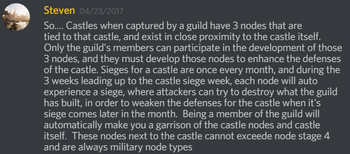
- ↑ 6.0 6.1 Pódcast, 2018-04-23 (15:14).
- ↑ 7.00 7.01 7.02 7.03 7.04 7.05 7.06 7.07 7.08 7.09 7.10 7.11 7.12 7.13 7.14 7.15 7.16 7.17 7.18 7.19 7.20 7.21 7.22 7.23 7.24 7.25 Blog - Know Your Nodes - The Basics.
- ↑ 8.0 8.1 Entrevista, 2018-08-24 (3:44).
- ↑ Transmisión en vivo, 2022-08-26 (1:18:54).
- ↑ Transmisión en vivo, 2022-08-26 (1:06:42).
- ↑ Transmisión en vivo, 2022-08-26 (1:05:47).
- ↑ 12.0 12.1 Transmisión en vivo, 2020-11-30 (37:16).
- ↑ 13.0 13.1 Transmisión en vivo, 2017-05-04 (15:15).
- ↑ 14.0 14.1 14.2 14.3 14.4 14.5 14.6 14.7 14.8 Know Your Nodes: Economic Node Type.
- ↑ 15.0 15.1 Transmisión en vivo, 2021-08-27 (1:19:43).
- ↑ Blog: Creative Director's Letter
- ↑ Entrevista, 2021-06-13 (56:35).
- ↑

- ↑ 19.00 19.01 19.02 19.03 19.04 19.05 19.06 19.07 19.08 19.09 19.10 19.11 19.12 19.13 19.14 19.15 19.16 19.17 MMOGames interview, January 2017
- ↑
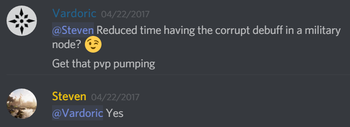
- ↑ 21.0 21.1 Blog: Know Your Nodes - Scientific Node Type
- ↑ Transmisión en vivo, 2020-03-28 (1:02:56).
- ↑

- ↑ Transmisión en vivo, 2018-07-09 (27:12).
- ↑ Transmisión en vivo, 2017-05-19 (53:24).
- ↑ 26.0 26.1 Vídeo, 2018-04-05 (41:48).
- ↑ 27.0 27.1 27.2 Entrevista, 2020-07-29 (17:26).
- ↑ 28.0 28.1 28.2 28.3 28.4 28.5 28.6 28.7 28.8

- ↑ 29.0 29.1 29.2 29.3 Entrevista, 2018-05-11 (50:05).
- ↑ 30.0 30.1 30.2 Transmisión en vivo, 2020-10-30 (1:01:00).
- ↑ Transmisión en vivo, 2017-05-26 (44:52).
- ↑ 32.0 32.1 32.2 32.3 32.4 32.5 32.6 32.7 32.8 32.9 Pódcast, 2021-09-29 (4:43).
- ↑ Entrevista, 2018-04-20 (7:22).
- ↑ Ashes of Creation FAQ.
- ↑ 35.0 35.1 Transmisión en vivo, 2018-07-09 (39:32).
- ↑ 36.0 36.1 Transmisión en vivo, 2019-03-29 (58:14).
- ↑ 37.0 37.1 37.2 37.3 37.4 Transmisión en vivo, 2019-03-29 (29:17).
- ↑ 38.0 38.1 Transmisión en vivo, 2017-05-05 (37:52).
- ↑ Entrevista, 2018-05-11 (55:16).
- ↑ 40.00 40.01 40.02 40.03 40.04 40.05 40.06 40.07 40.08 40.09 40.10 Transmisión en vivo, 2021-09-24 (30:26).
- ↑ 41.00 41.01 41.02 41.03 41.04 41.05 41.06 41.07 41.08 41.09 41.10 41.11 41.12 41.13 41.14 41.15 41.16 41.17 41.18 41.19 41.20 41.21 41.22 Blog - Know Your Nodes - Advance and Destroy.
- ↑ 42.0 42.1 Transmisión en vivo, 2018-12-12 (14:48).
- ↑ Entrevista, 2020-07-20 (3:45).
- ↑ Vídeo, 2017-04-20 (0:02).
- ↑
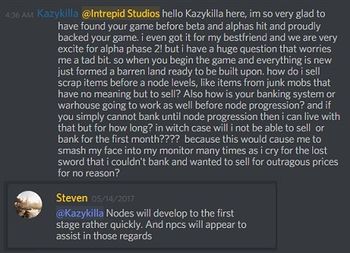
- ↑ 46.0 46.1 Transmisión en vivo, 2017-10-16 (50:20).
- ↑ 47.0 47.1 47.2

- ↑ 48.0 48.1 48.2 48.3

- ↑ 49.0 49.1 49.2 Entrevista, 2020-07-18 (10:04).
- ↑ 50.0 50.1 50.2 50.3 50.4 50.5 Entrevista, 2020-07-08 (1:00:15).
- ↑
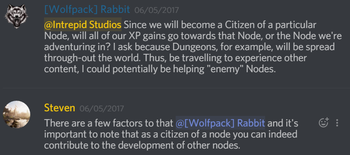
- ↑ Transmisión en vivo, 2021-09-24 (1:21:23).
- ↑ 53.0 53.1 Transmisión en vivo, 2017-05-26 (28:16).
- ↑ 54.0 54.1 54.2 54.3 54.4 Transmisión en vivo, 2022-10-14 (55:13).
- ↑ Transmisión en vivo, 2017-11-17 (55:27).
- ↑ 56.0 56.1 56.2 56.3 Transmisión en vivo, 2022-08-26 (1:07:34).
- ↑ 57.0 57.1 57.2

- ↑ 58.0 58.1 Transmisión en vivo, 2022-08-26 (1:04:35).
- ↑ 59.0 59.1 59.2 59.3 59.4 Transmisión en vivo, 2022-08-26 (1:10:16).
- ↑ Entrevista, 2020-07-19 (19:35).
- ↑ Transmisión en vivo, 2017-05-15 (30:53).
- ↑ Interview: Ashes of Creation on Building Their Virtual World, 2017-04-13.
- ↑ Entrevista, 2020-07-19 (1:10:55).
- ↑ Transmisión en vivo, 2022-10-14 (57:22).
- ↑ 65.0 65.1 65.2 65.3 Entrevista, 2020-07-19 (1:08:22).
- ↑ Transmisión en vivo, 2020-03-28 (1:02:46).
- ↑ 67.0 67.1 67.2 67.3 67.4 Transmisión en vivo, 2019-07-26 (1:20:48).
- ↑ 68.0 68.1 68.2 Transmisión en vivo, 2017-11-17 (9:49).
- ↑ 69.0 69.1 Transmisión en vivo, 2020-07-25 (1:52:45).
- ↑ 70.0 70.1

- ↑ 71.0 71.1 Transmisión en vivo, 2017-06-30 (53:57).
- ↑ Entrevista, 2018-10-20 (2:36).
- ↑ 73.0 73.1 Transmisión en vivo, 2022-08-26 (1:12:40).
- ↑ 74.0 74.1 74.2 74.3 74.4 Transmisión en vivo, 2022-04-29 (27:42).
- ↑ 75.0 75.1 Transmisión en vivo, 2021-12-23 (1:30:34).
- ↑ Transmisión en vivo, 2020-03-28 (1:01:34).
- ↑ 77.0 77.1 77.2 77.3 77.4 Entrevista, 2020-03-27 (6:03).
- ↑
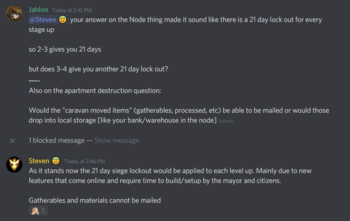
- ↑

- ↑

- ↑ 81.0 81.1 81.2 81.3 Entrevista, 2020-07-19 (26:54).
- ↑ Transmisión en vivo, 2021-03-26 (1:18:26).
- ↑ Transmisión en vivo, 2021-11-19 (51:56).
- ↑

- ↑ Pódcast, 2018-05-11 (52:20).
- ↑ 86.0 86.1 Entrevista, 2020-03-27 (09:05).
- ↑ Entrevista, 2020-03-27 (11:04).
- ↑ Transmisión en vivo, 2021-03-26 (1:17:20).
- ↑
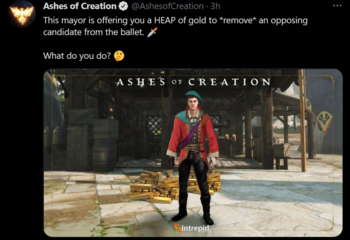
- ↑

- ↑ 91.0 91.1 91.2 91.3 91.4 City hall.
- ↑ 92.0 92.1

- ↑ 93.0 93.1 93.2 Transmisión en vivo, 2020-03-28 (1:03:38).
- ↑ 94.0 94.1

- ↑ 95.0 95.1

- ↑ Transmisión en vivo, 2020-07-25 (1:22:40).
- ↑ Transmisión en vivo, 2018-01-18 (37:05).
- ↑ Transmisión en vivo, 2020-06-26 (59:11).
- ↑ 99.0 99.1

- ↑ 100.0 100.1 100.2 100.3 Entrevista, 2020-07-08 (1:04:05).
- ↑

- ↑ Transmisión en vivo, 2017-05-19 (36:05).
- ↑ 103.0 103.1 103.2 Entrevista, 2018-05-11 (47:27).
- ↑ Transmisión en vivo, 2017-05-19 (36:09).
- ↑
- ↑ Entrevista, 2020-03-27 (0:30).
- ↑ 107.0 107.1 Entrevista, 2018-05-11 (57:02).
- ↑ 108.0 108.1 Entrevista, 2020-07-19 (24:34).
- ↑ 109.0 109.1

- ↑ Transmisión en vivo, 2017-05-24 (40:50).
- ↑ 111.0 111.1 Transmisión en vivo, 2019-06-28 (1:26:14).
- ↑ 112.0 112.1 112.2 112.3 112.4 Pódcast, 2018-05-11 (21:07).
- ↑ Transmisión en vivo, 2023-08-31 (2:10:23).
- ↑ 114.0 114.1 114.2 114.3 114.4 114.5 Vídeo, 2024-02-29 (2:19).
- ↑ Vídeo, 2024-02-29 (4:18).
- ↑ 116.0 116.1 116.2 Transmisión en vivo, 2024-02-29 (57:27).
- ↑
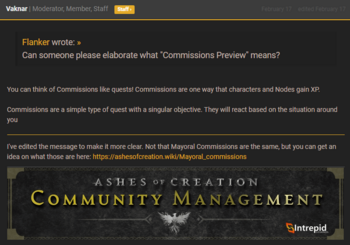
- ↑ 118.0 118.1

- ↑ 119.0 119.1 119.2 119.3 119.4 119.5 119.6 Transmisión en vivo, 2023-08-31 (42:05).
- ↑ Alpha-1 screenshot.
- ↑ Alpha-1 screenshot.
- ↑ Transmisión en vivo, 2017-05-12 (42:17).
- ↑ 123.0 123.1 123.2

- ↑ 124.0 124.1 Vídeo, 2024-02-29 (13:11).
- ↑ 125.0 125.1 125.2 Vídeo, 2024-02-29 (5:11).
- ↑ 126.0 126.1

- ↑ 127.0 127.1 Transmisión en vivo, 2024-02-29 (50:29).
- ↑ 128.0 128.1 Transmisión en vivo, 2024-02-29 (1:18:21).
- ↑ Vídeo, 2024-02-29 (26:17).
- ↑ 130.0 130.1 130.2 130.3 130.4 130.5 Blog: Development Update with Village Node.
- ↑ 131.0 131.1 131.2 131.3 131.4 131.5 131.6 131.7 Transmisión en vivo, 2023-08-31 (39:17).
- ↑ Transmisión en vivo, 2023-08-31 (43:07).
- ↑ Transmisión en vivo, 2023-08-31 (43:27).
- ↑ 134.0 134.1 134.2 134.3 134.4 134.5 Transmisión en vivo, 2021-12-23 (1:26:36).
- ↑ Transmisión en vivo, 2023-02-24 (1:22:04).
- ↑
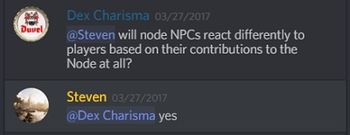
- ↑ Transmisión en vivo, 2020-02-28 (1:14:38).
- ↑ Transmisión en vivo, 2017-11-17 (29:45).
- ↑ Transmisión en vivo, 2020-03-28 (1:16:03).
- ↑ Vídeo, 2020-03-23 (0:24).
- ↑ 141.0 141.1 141.2 141.3 141.4 Transmisión en vivo, 2017-05-19 (33:57).
- ↑ 142.0 142.1 Transmisión en vivo, 2018-01-20 (38:17).
- ↑ Transmisión en vivo, 2018-04-8 (PM) (51:49).
- ↑ Entrevista, 2020-07-08 (55:05).
- ↑ 145.0 145.1 145.2 145.3 145.4 145.5 145.6 145.7 145.8 Transmisión en vivo, 2022-03-31 (1:13:00).
- ↑ Transmisión en vivo, 2021-07-30 (1:10:09).
- ↑ 147.0 147.1 147.2 147.3 147.4 147.5 Transmisión en vivo, 2018-09-27 (53:06).
- ↑ 148.0 148.1 Transmisión en vivo, 2022-02-25 (41:00).
- ↑ 149.0 149.1 149.2 149.3 149.4 149.5 Transmisión en vivo, 2020-10-30 (39:17).
- ↑ 150.0 150.1 Transmisión en vivo, 2021-02-26 (1:12:18).
- ↑ Pódcast, 2021-04-11 (29:47).
- ↑ Entrevista, 2018-05-11 (54:34).
- ↑ Transmisión en vivo, 2017-05-26 (21:23).
- ↑ Pódcast, 2021-04-11 (23:36).
- ↑ 155.0 155.1 Transmisión en vivo, 2022-07-29 (1:13:09).
- ↑ Transmisión en vivo, 2020-06-26 (45:32).
- ↑ 157.0 157.1 157.2 157.3 157.4 157.5 Transmisión en vivo, 2022-03-31 (4:57).
- ↑ 158.0 158.1 Entrevista, 2021-02-07 (33:00).
- ↑ 159.0 159.1 Entrevista, 2018-05-11 (1:00:19).
- ↑ 160.0 160.1 160.2 Pódcast, 2018-04-23 (29:56).
- ↑ 161.0 161.1 Entrevista, 2023-07-09 (1:35:28).
- ↑ Transmisión en vivo, 2018-09-01 (36:28).
- ↑ Transmisión en vivo, 2017-05-10 (28:09).
- ↑ Transmisión en vivo, 2017-05-12 (49:50).
- ↑ Transmisión en vivo, 2022-04-29 (21:00).
- ↑ 166.0 166.1 166.2 166.3 Pódcast, 2021-09-29 (10:49).
- ↑ 167.0 167.1 167.2 Entrevista, 2020-07-18 (56:11).
- ↑ 168.0 168.1 Transmisión en vivo, 2022-04-29 (27:00).
- ↑ Transmisión en vivo, 2019-10-31 (36:20).
- ↑ 170.0 170.1 Transmisión en vivo, 2019-11-22 (16:56).
- ↑ 171.0 171.1 171.2 171.3 171.4 171.5 171.6 171.7 Entrevista, 2020-07-08 (57:46).
- ↑ Forums - Livestream Q&A 2022-08-26.
- ↑ 173.0 173.1 173.2 Transmisión en vivo, 2019-11-22 (17:59).
- ↑ Entrevista, 2020-07-08 (59:38).
- ↑ 175.0 175.1 175.2 175.3 175.4 175.5 Pódcast, 2021-09-29 (14:21).
- ↑ 176.0 176.1 176.2 Transmisión en vivo, 2020-04-30 (1:14:44).
- ↑ 177.0 177.1 177.2

- ↑ 178.0 178.1 178.2 Transmisión en vivo, 2020-06-26 (1:02:12).
- ↑ 179.0 179.1 179.2 179.3 179.4 179.5 179.6 Transmisión en vivo, 2017-07-18 (40:14).
- ↑ 180.0 180.1 180.2 Transmisión en vivo, 2017-11-17 (47:10).
- ↑ Vídeo, 2017-05-25 (1:07).
- ↑ About Ashes of Creation.
- ↑ Transmisión en vivo, 2018-05-04 (32:46).
- ↑

- ↑ 185.0 185.1 185.2 185.3 185.4 Steven Sharif - Clarification points from today’s stream.
- ↑ 186.0 186.1 186.2 186.3 186.4 186.5

- ↑ 187.0 187.1 187.2 187.3 Entrevista, 2018-05-11 (50:47).
- ↑ Vídeo, 2020-05-31 (38:50).
- ↑ Transmisión en vivo, 2017-05-19 (33:57).
- ↑ 190.0 190.1 190.2 Entrevista, 2020-07-08 (33:34).
- ↑ 191.0 191.1 Transmisión en vivo, 2017-05-12 (52:01).
- ↑ Transmisión en vivo, 2020-05-29 (36:29).
- ↑ Transmisión en vivo, 2020-05-29 (42:01).
- ↑ Transmisión en vivo, 2020-05-29 (35:36).
- ↑ 195.0 195.1 Transmisión en vivo, 2017-10-16 (56:42).
- ↑ Entrevista, 2020-07-08 (45:23).
- ↑ 197.0 197.1 197.2 Transmisión en vivo, 2020-06-26 (47:32).
- ↑ 198.0 198.1 198.2 Transmisión en vivo, 2022-06-30 (1:09:29).
- ↑ Transmisión en vivo, 2022-02-25 (1:12:27).
- ↑ Pódcast, 2021-04-11 (40:20).
- ↑ Entrevista, 2020-03-27 (9:00).
- ↑ Transmisión en vivo, 2017-05-05 (34:15).
- ↑ 203.0 203.1 Transmisión en vivo, 2022-06-30 (1:08:02).
- ↑ 204.0 204.1 204.2 204.3 204.4 204.5 Transmisión en vivo, 2017-10-16 (56:38).
- ↑ 205.0 205.1 Transmisión en vivo, 2020-06-26 (53:41).
- ↑ 206.0 206.1 206.2 206.3 Transmisión en vivo, 2017-05-12 (55:01).
- ↑ Transmisión en vivo, 2020-06-26 (54:03).
- ↑ Transmisión en vivo, 2020-06-26 (56:08).
- ↑ 209.0 209.1 209.2 209.3 Transmisión en vivo, 2019-05-30 (1:23:41).
- ↑ Vídeo, 2016-12-04 (0:02).
- ↑ Twitch Bustin - Practice Sieges?
- ↑ Transmisión en vivo, 2020-12-22 (1:13:51).
- ↑ Vídeo, 2017-04-30 (5:31).
- ↑ Transmisión en vivo, 2022-01-28 (17:50).
- ↑ 215.0 215.1 215.2 215.3 215.4 Transmisión en vivo, 2022-10-14 (52:31).
- ↑ 216.0 216.1 Pódcast, 2021-09-29 (15:46).
- ↑ Transmisión en vivo, 2020-06-26 (1:48:43).
- ↑

- ↑

- ↑ Transmisión en vivo, 2020-06-26 (1:00:57).
- ↑ Transmisión en vivo, 2021-03-26 (59:21).
- ↑ 222.0 222.1 222.2 Transmisión en vivo, 2020-08-28 (2:04:00).
- ↑ 223.0 223.1 223.2 Transmisión en vivo, 2017-05-19 (28:04).
- ↑ Transmisión en vivo, 2017-05-19 (29:34).
- ↑ Transmisión en vivo, 2021-02-26 (1:11:13).
- ↑ 226.0 226.1 226.2 226.3 Transmisión en vivo, 2017-05-24 (52:39).
- ↑ Transmisión en vivo, 2017-05-26 (31:44).
- ↑ Transmisión en vivo, 2017-05-26 (42:45).
- ↑ Transmisión en vivo, 2017-05-24 (31:39).
- ↑ Transmisión en vivo, 2018-08-17 (58:53).
- ↑ 231.0 231.1 231.2 Transmisión en vivo, 2018-04-8 (PM) (1:01:28).
- ↑ 232.0 232.1 Entrevista, 2020-07-19 (48:05).
- ↑ Transmisión en vivo, 2017-05-19 (37:51).
- ↑ Transmisión en vivo, 2017-05-17 (30:53).
- ↑ Kickstarter - We Just Broke $1,500,000!
- ↑ Transmisión en vivo, 2018-04-8 (AM) (18:29).
- ↑ Pódcast, 2018-04-23 (24:47).
- ↑ 238.0 238.1 238.2 238.3 238.4 238.5 Transmisión en vivo, 2020-02-28 (1:06:51).
- ↑ 239.0 239.1 239.2 239.3 239.4 Transmisión en vivo, 2019-06-28 (1:27:23).
- ↑ 240.0 240.1 Transmisión en vivo, 2017-05-17 (11:27).
- ↑ 241.0 241.1

- ↑ 242.0 242.1 Entrevista, 2018-10-20 (5:51).

